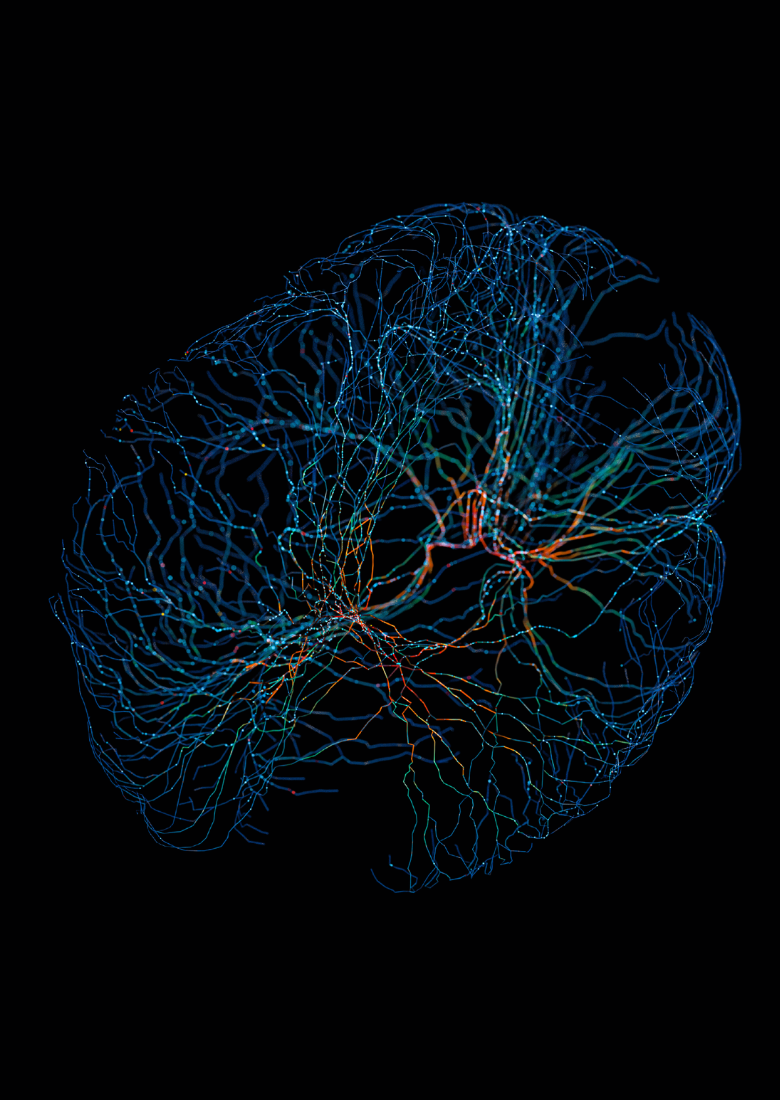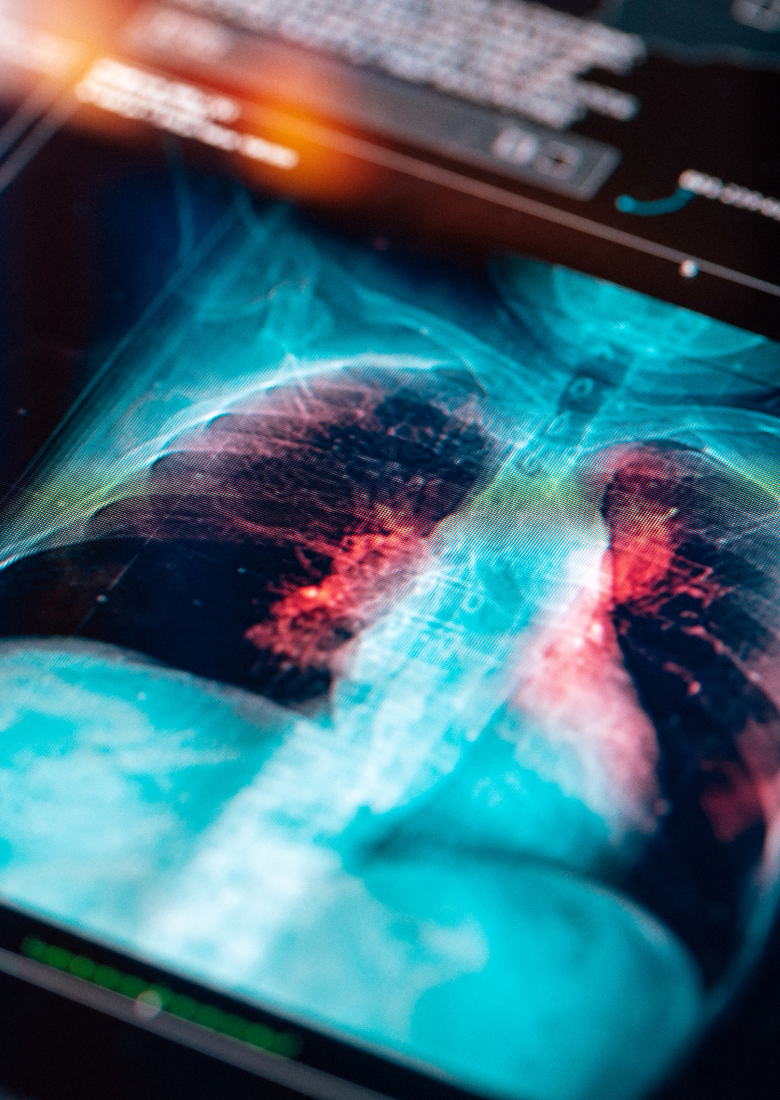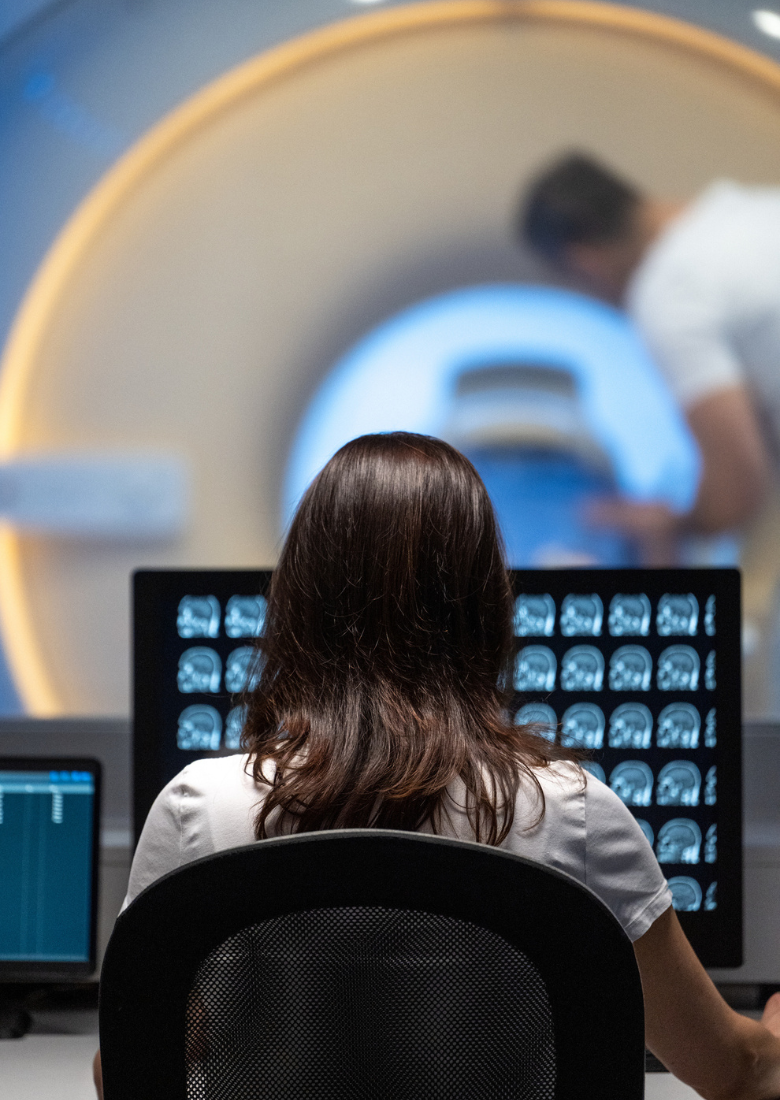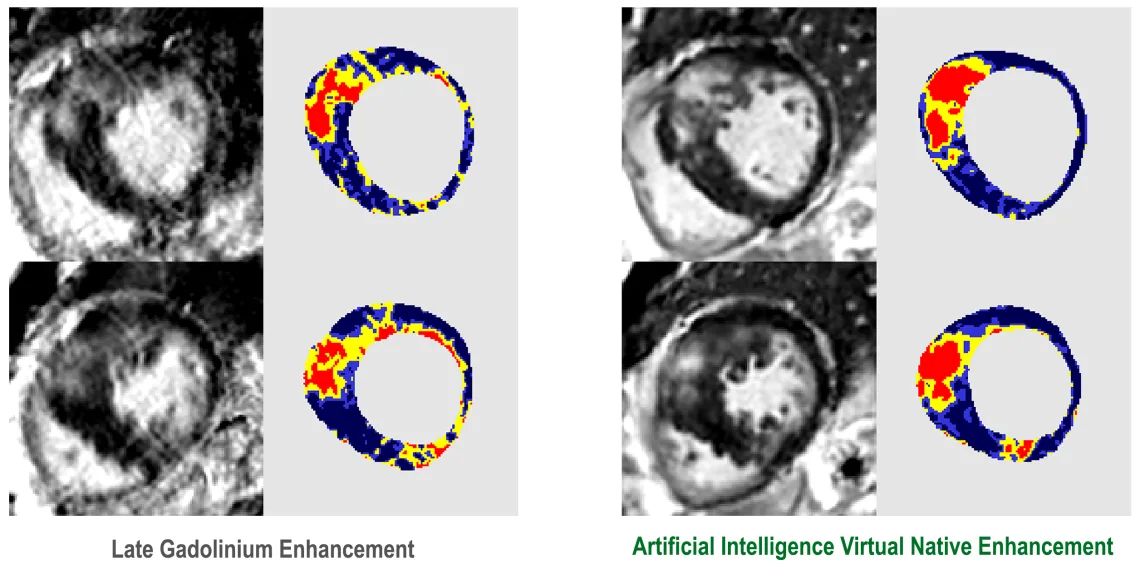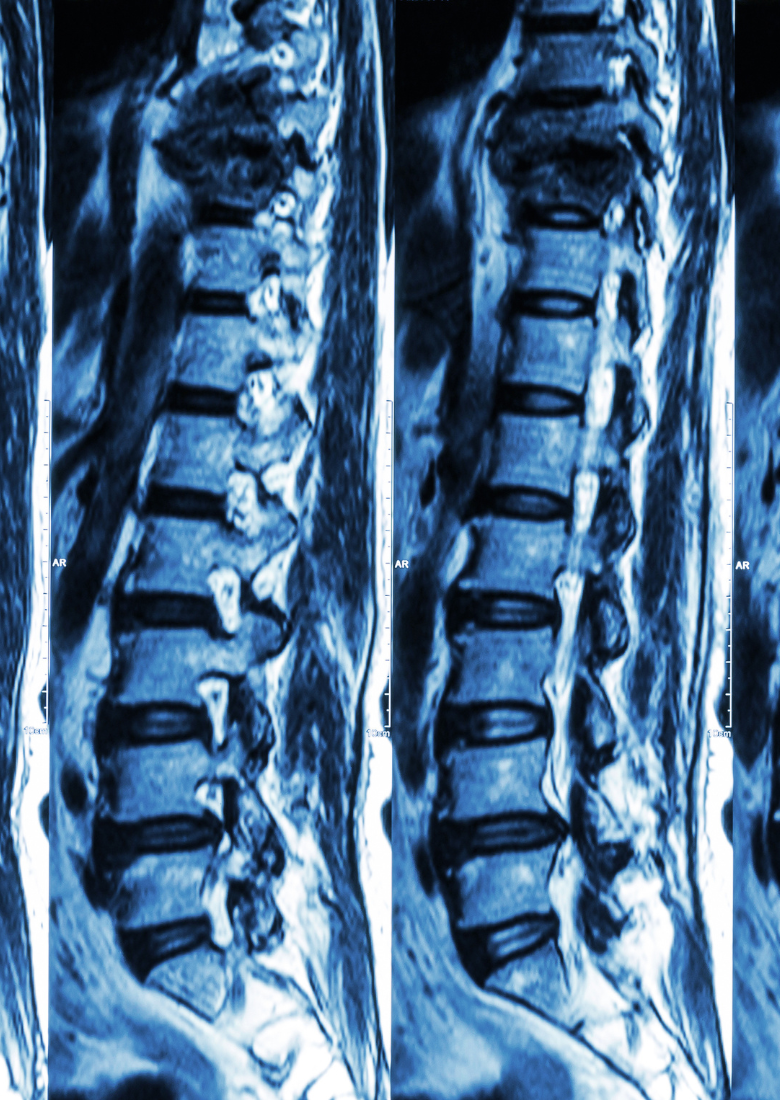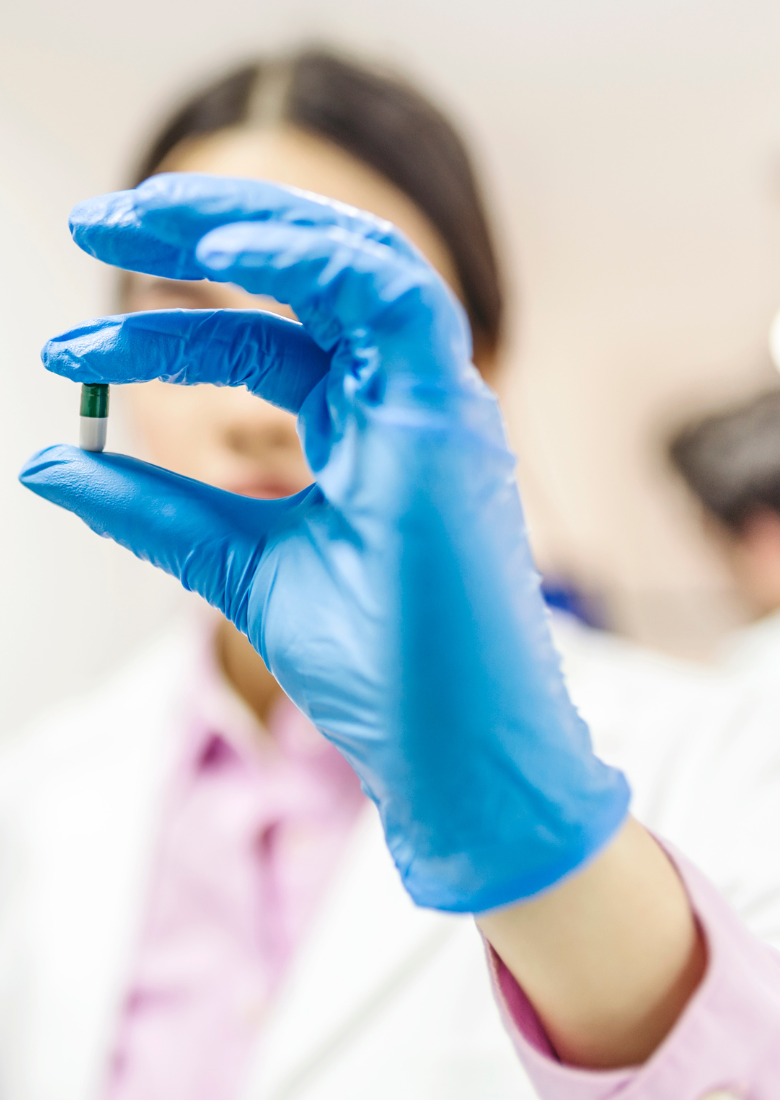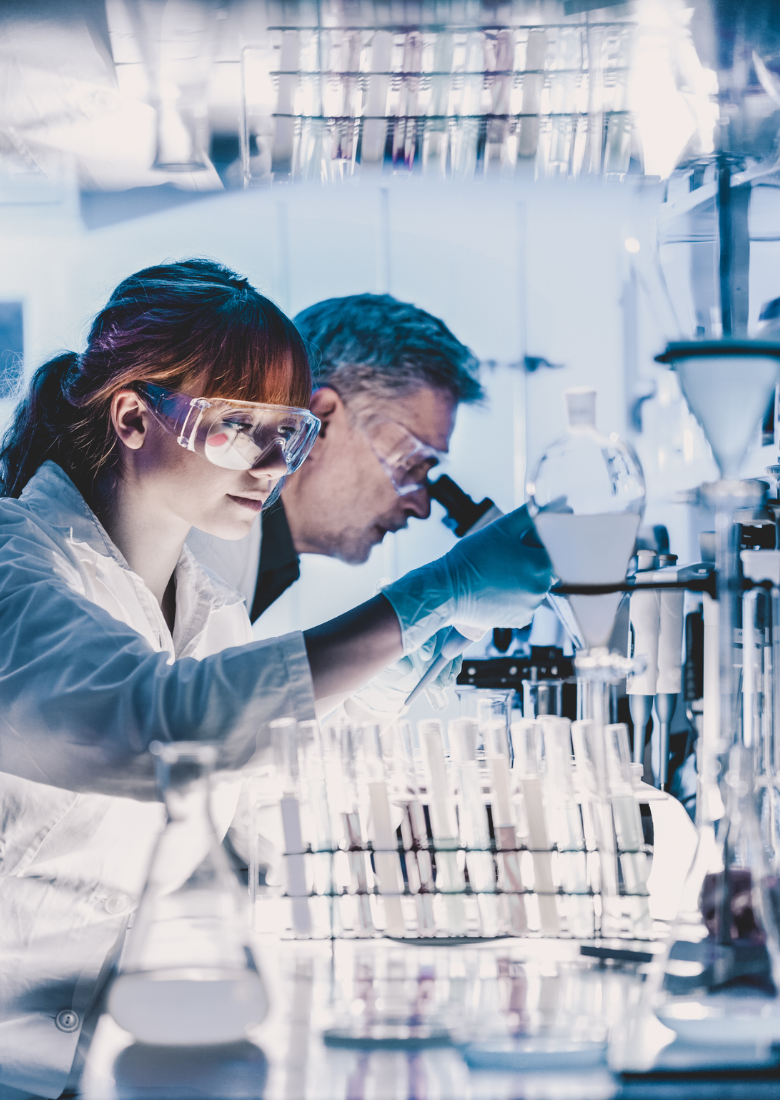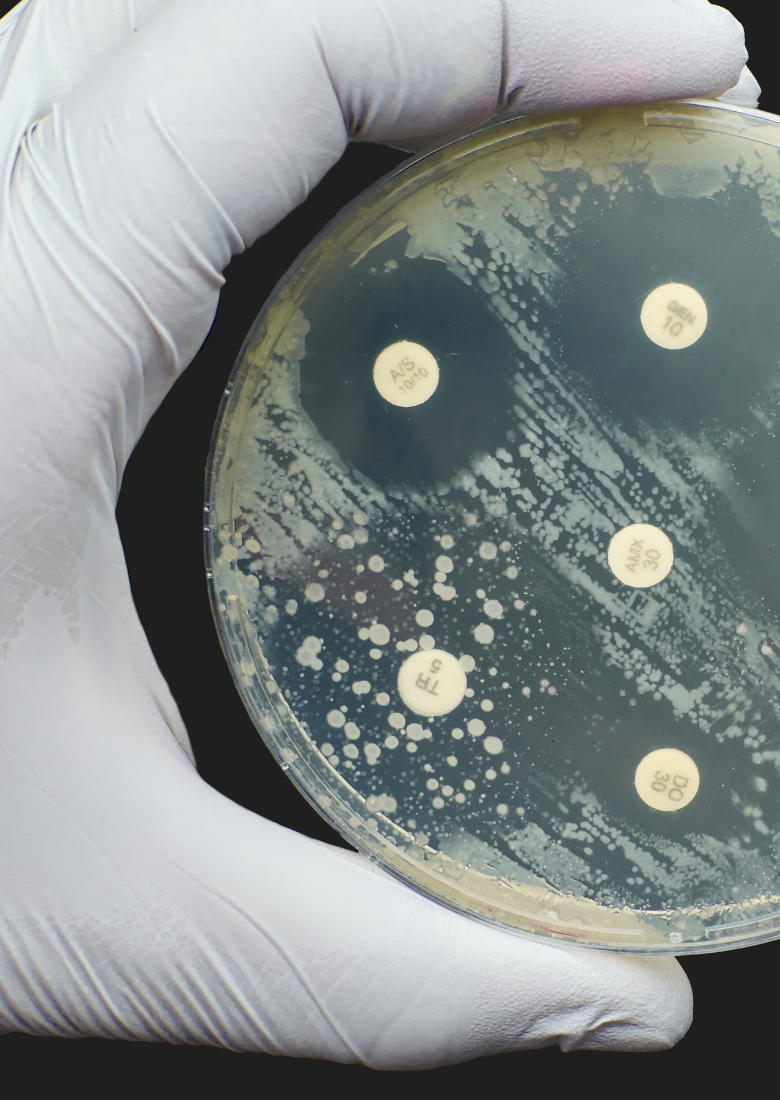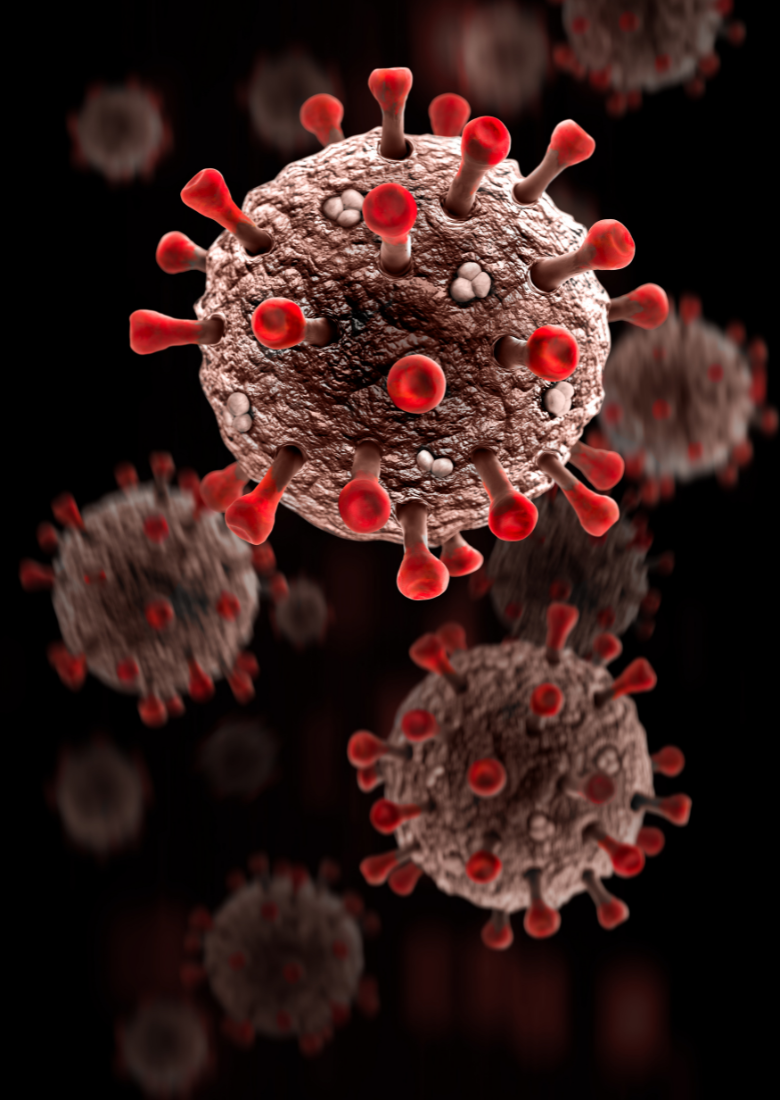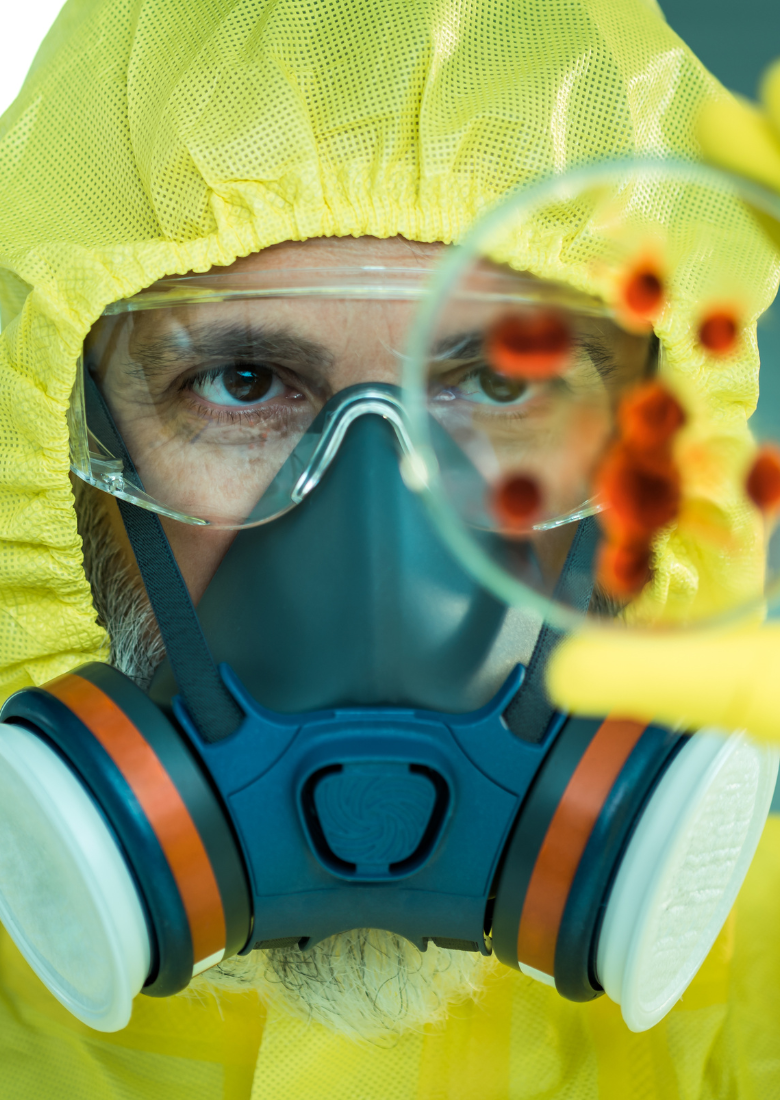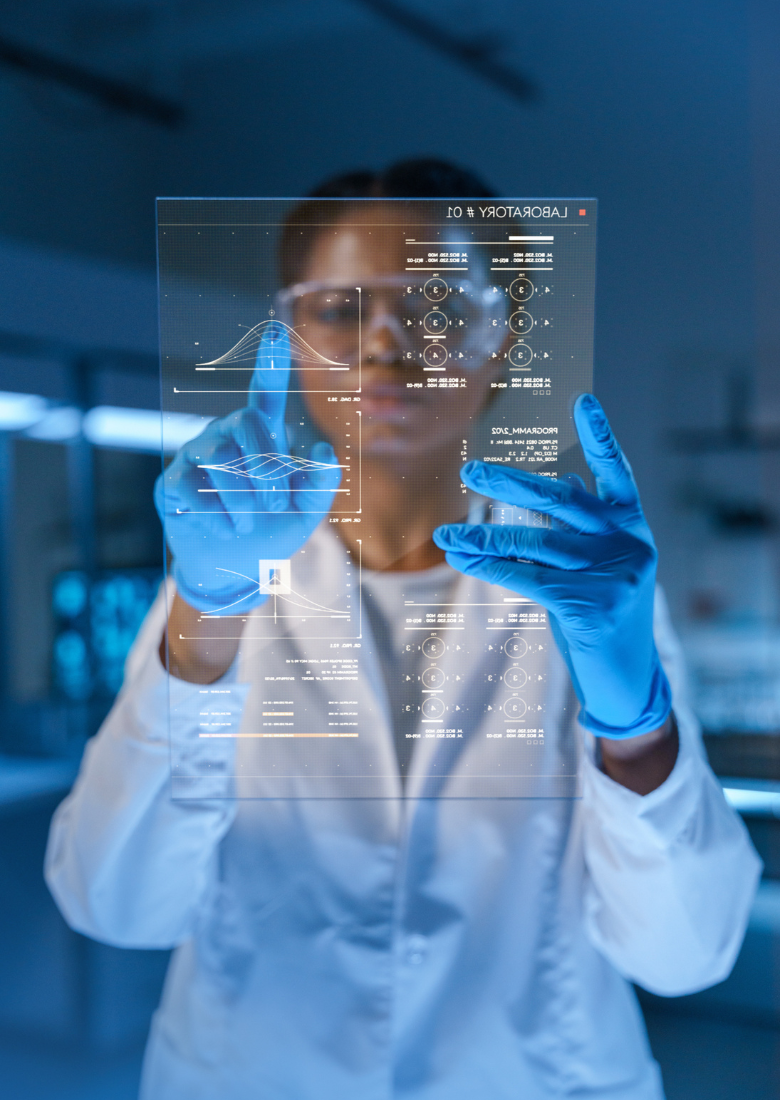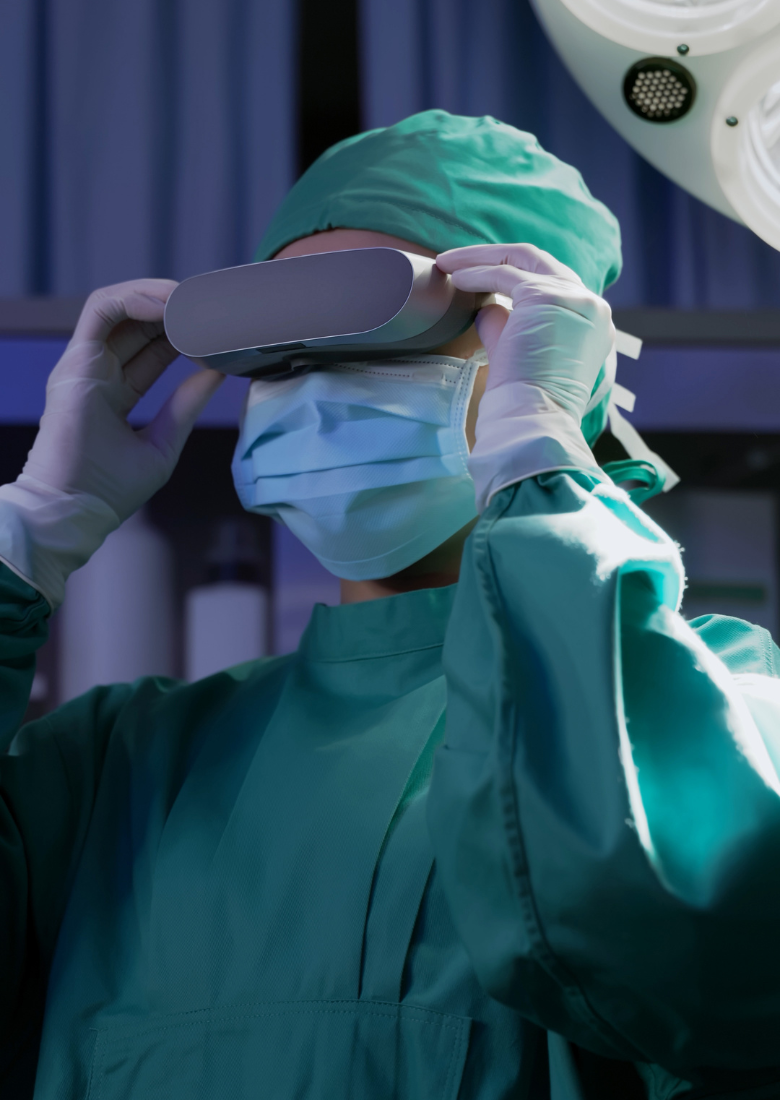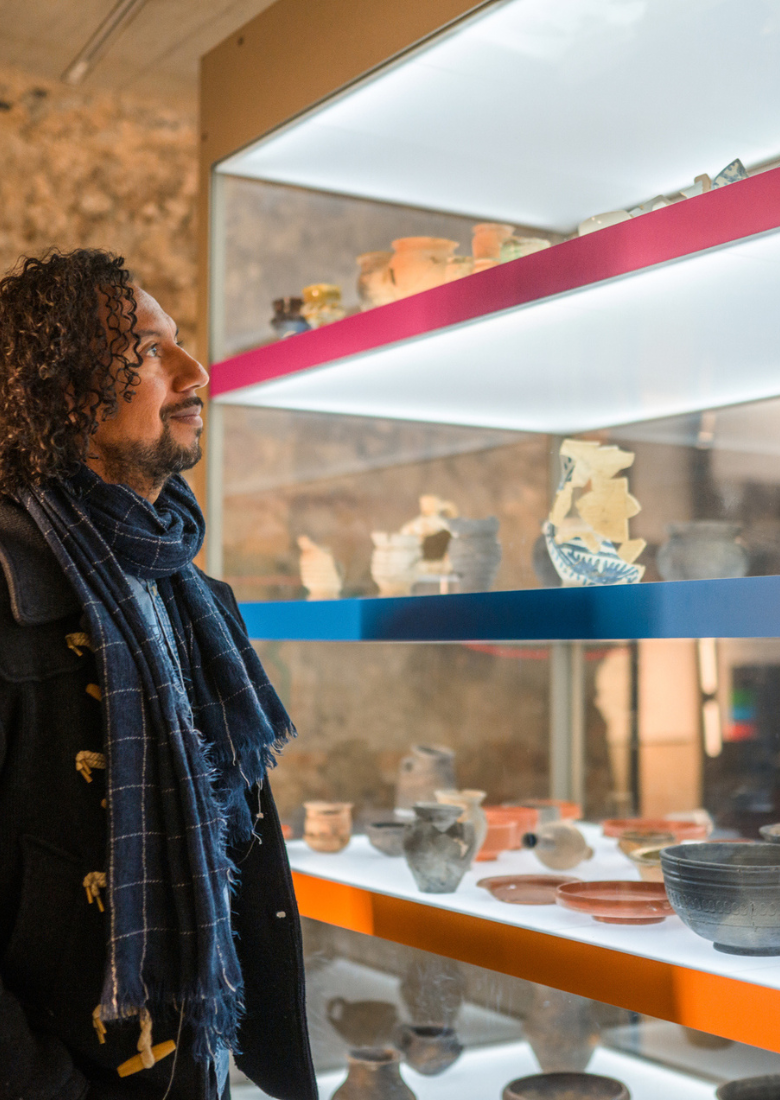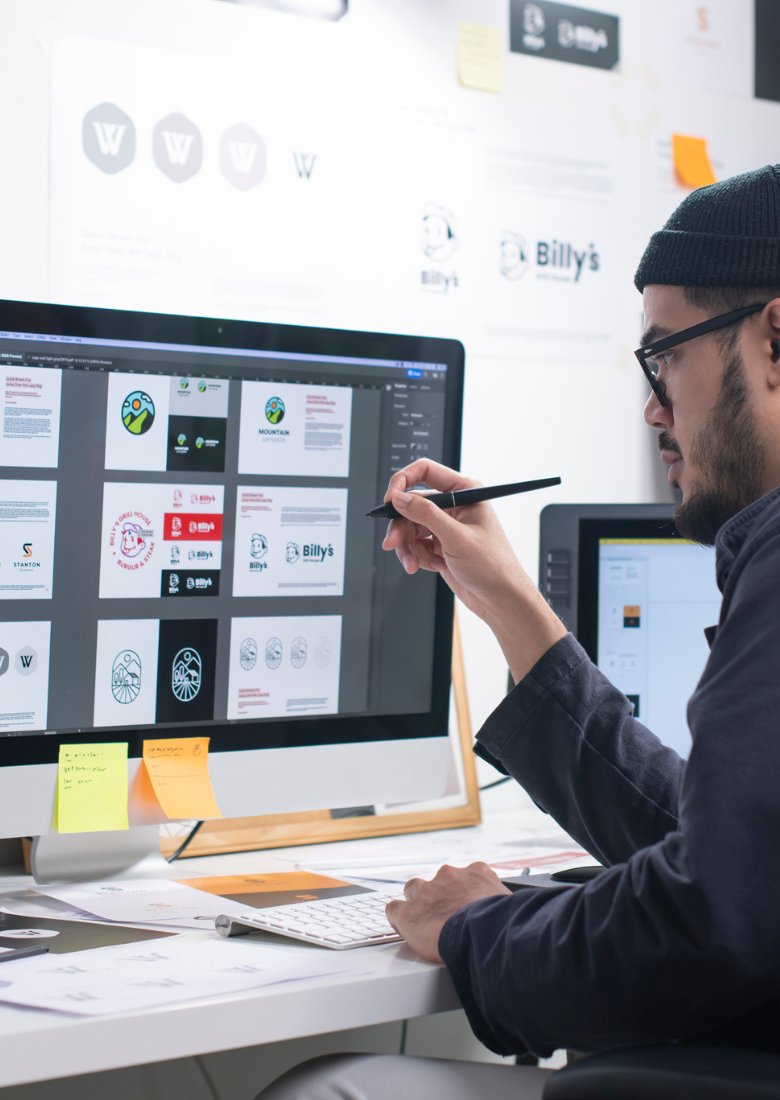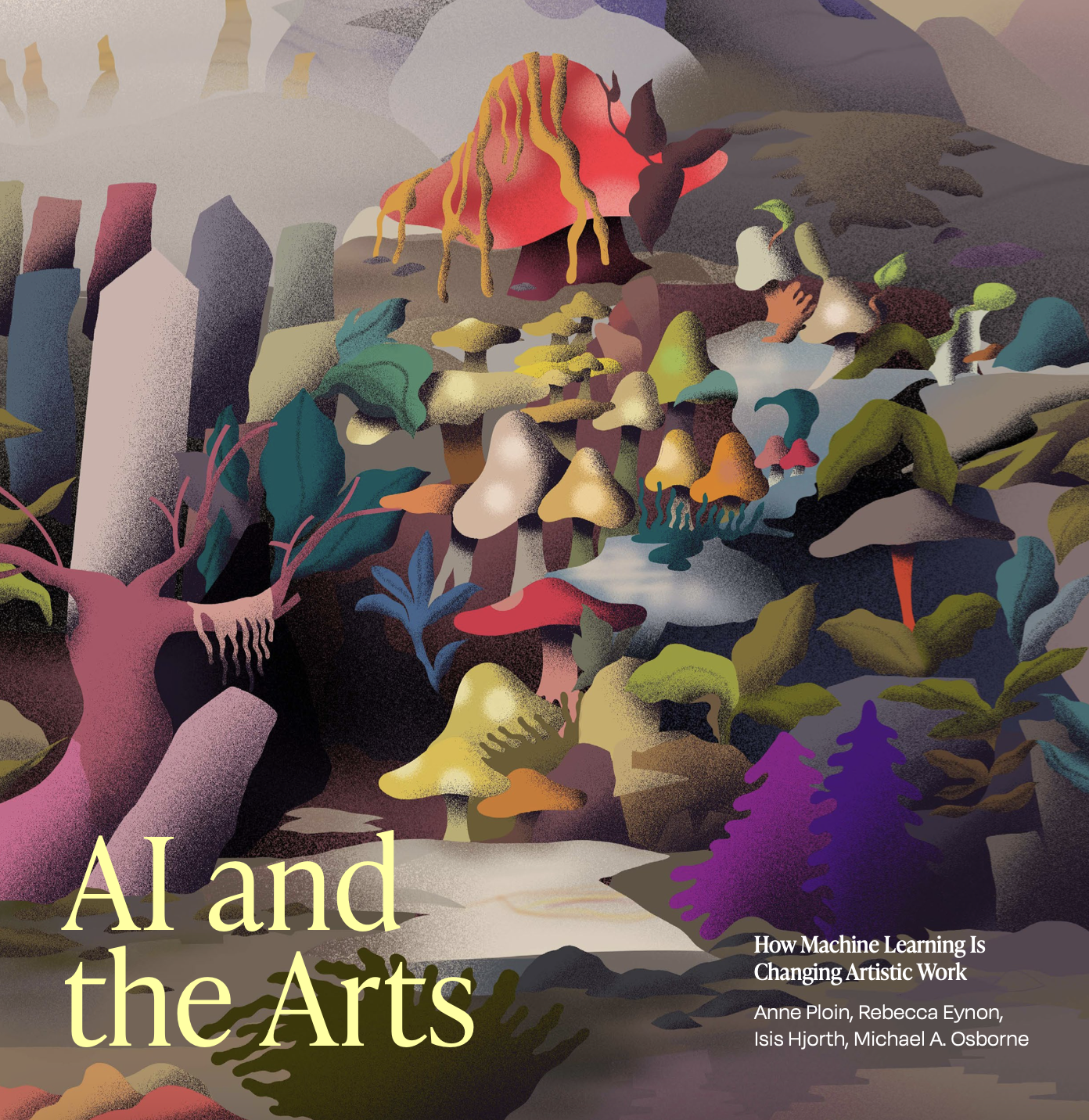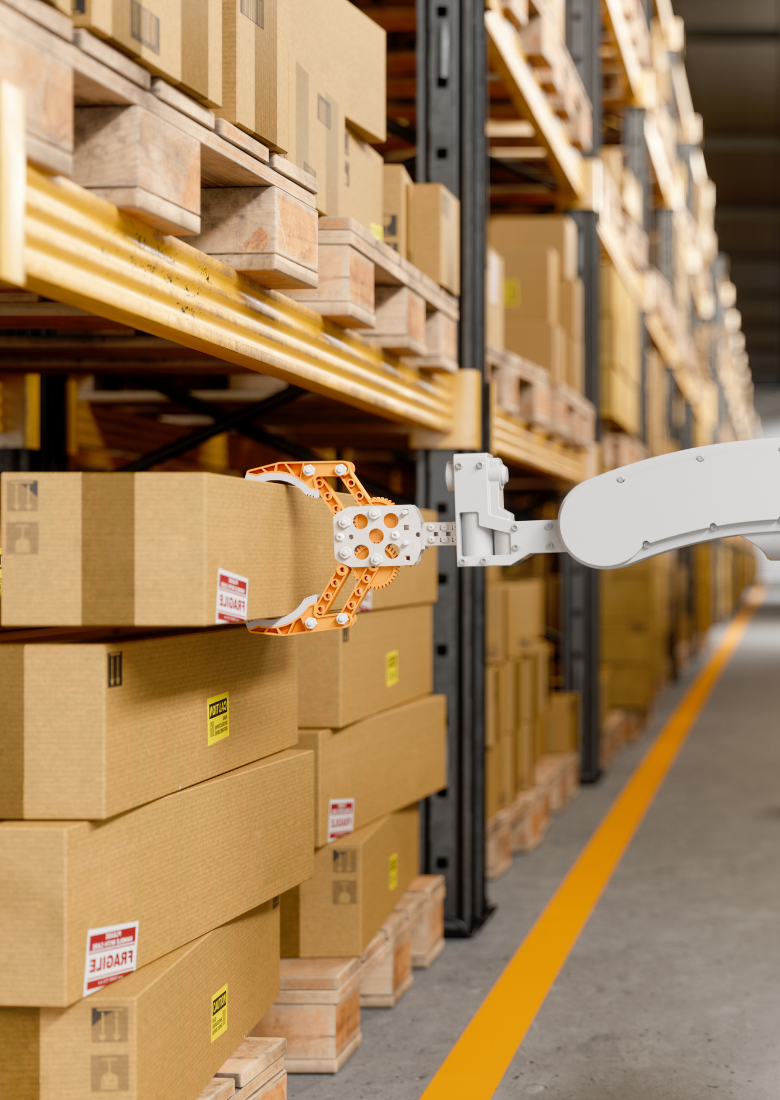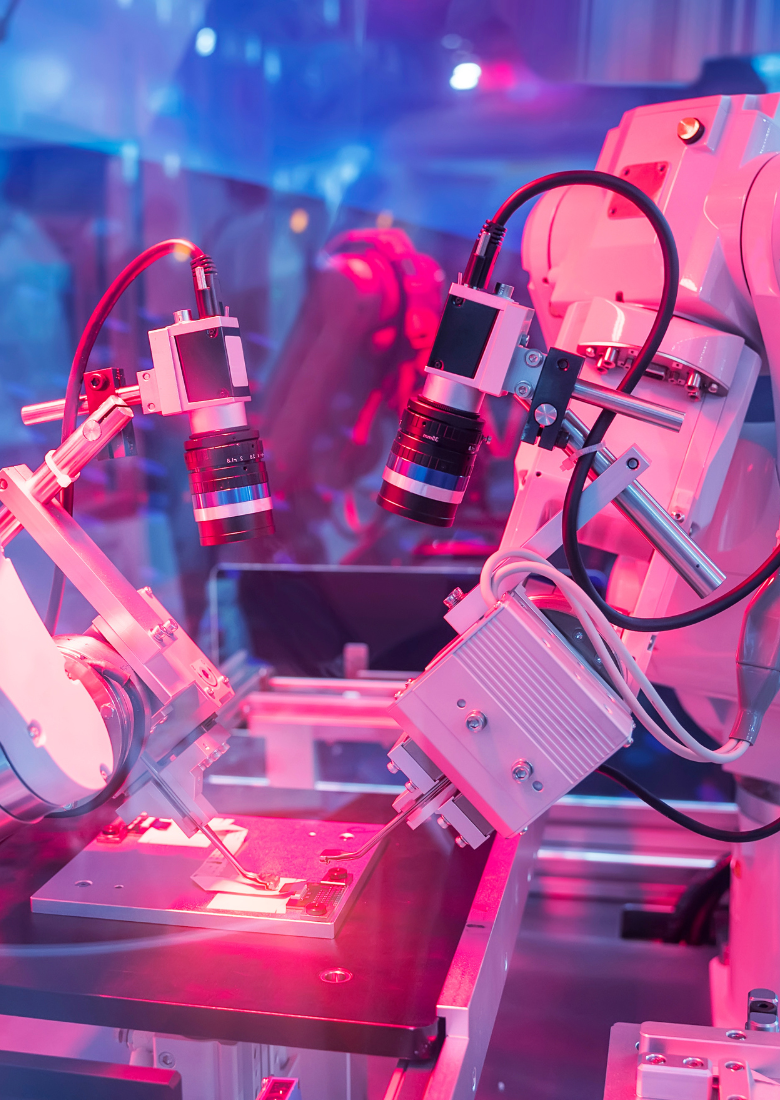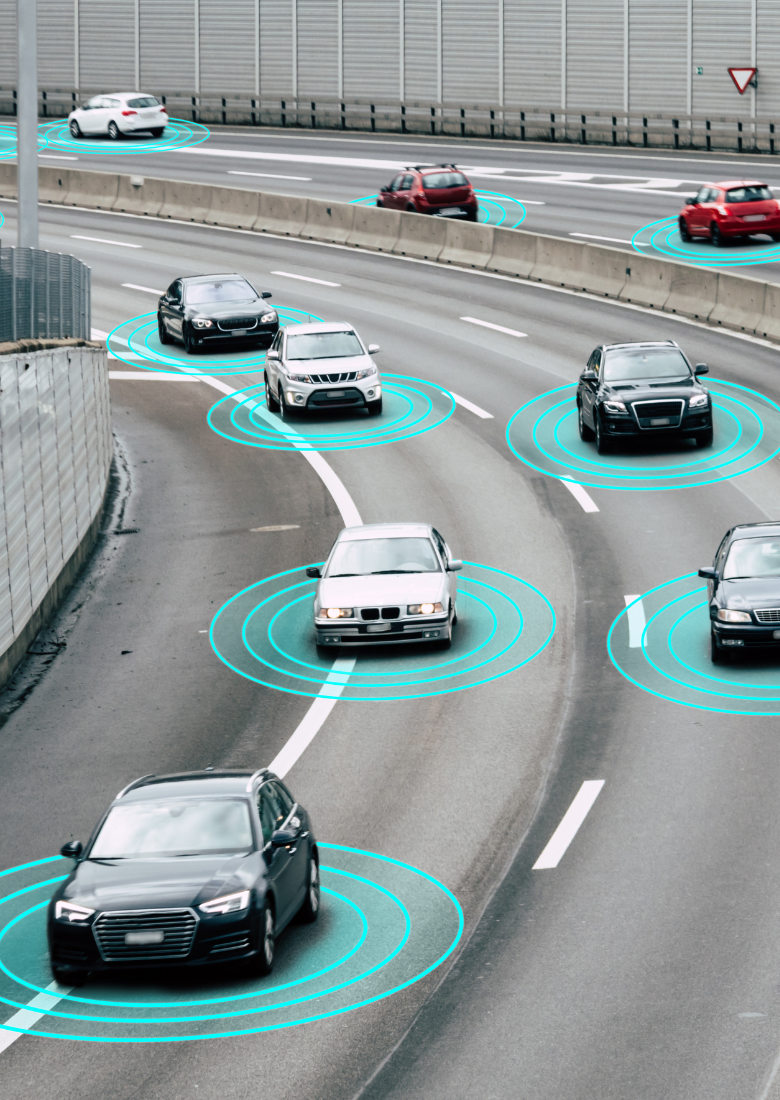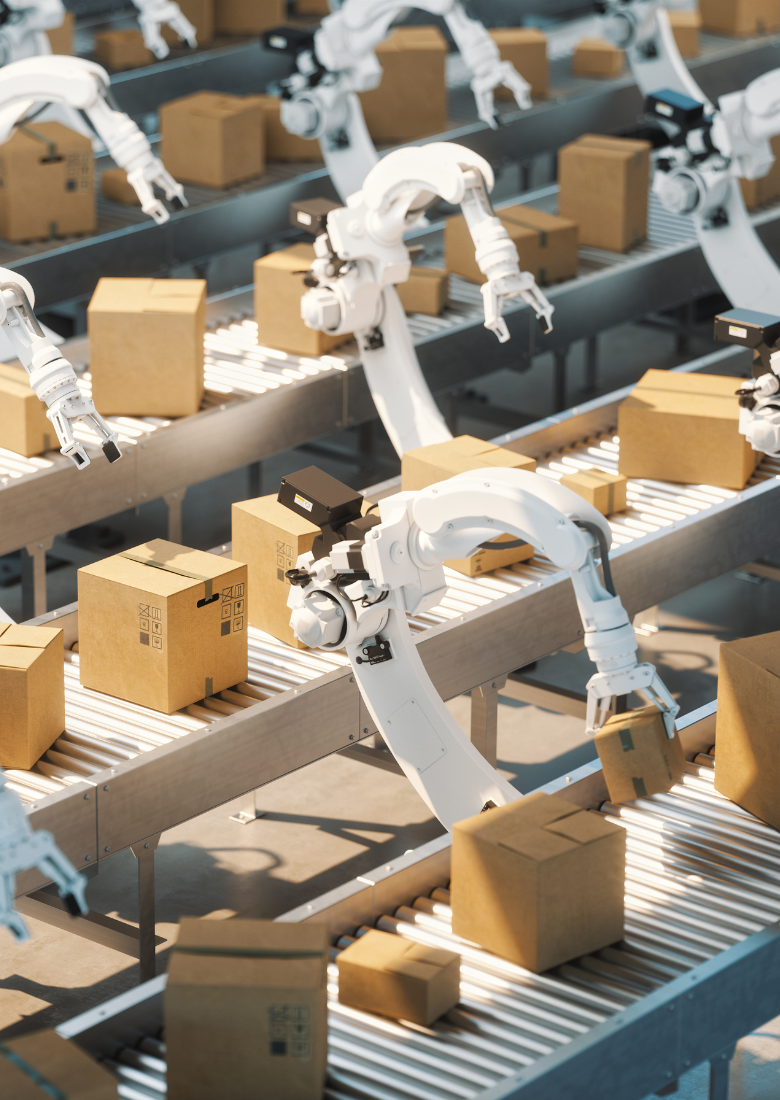How is artifical intelligence being used at Oxford?

Oxford experts are applying AI to society's greatest challenges.
They're using artificial intelligence to tackle global health issues, from identifying psychiatric disorders to predicting the spread of future pandemics.
Researchers are using AI to curate exhibitions and compose symphonies, monitor the illegal wildlife trade and look for life on Mars.
They're analysing the impact of artificial intelligence on the workplace and leading the way in exploring the ethical issues of AI's impact on humanity.
Global health, medicine and disease.
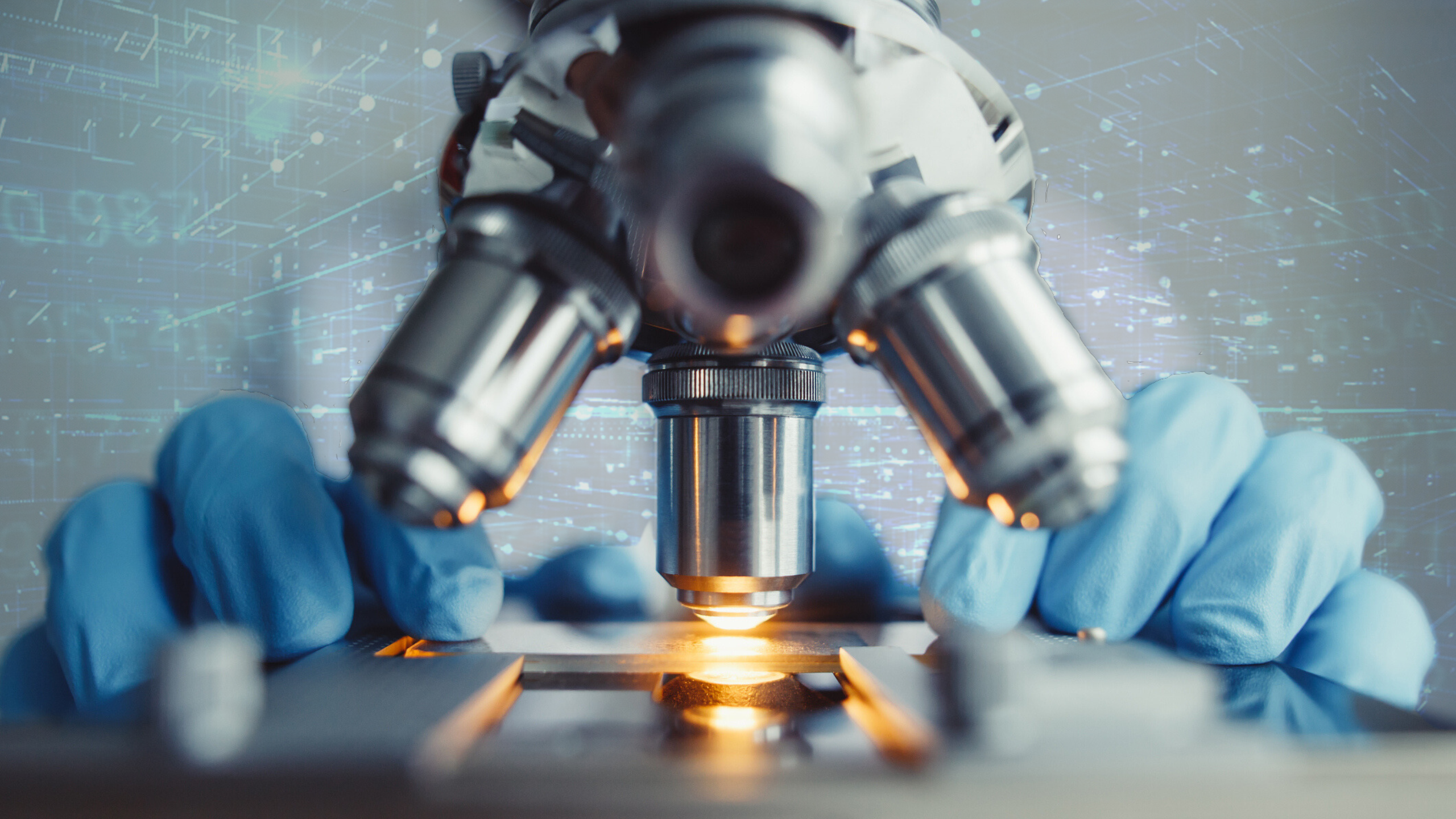
Experts at Oxford are using AI to enhance our healthcare provision, detect diseases with more accuracy and help us understand our bodies better.
They’re not only developing and improving therapies and treatments using artificial intelligence but are also working to drive change and deliver safeguarding in the governance of new health technologies being used globally.
Understanding the brain and cognitive decline.
Researchers in the Costa Group, led by Dr Rui Ponte Costa, are seeking to understand the principles underlying learning in the brain by developing a new generation of computational models of learning, driven by recent machine learning developments.
Dr Costa’s Neural and Machine Learning Group, part of Oxford Neuroscience and Oxford Neurotheory, have made a number of major breakthroughs, including the introduction of a AI-driven theory of cholinergic neuromodulation that explains brain learning speed-up and its role in cognitive decline.
‘Machine learning helps researchers speed up of the process of analysing complex and varied real world data and assists in developing prediction models for dementia’
Along with colleagues from a number of other institutions, researchers also used machine learning techniques to analyse complex data in order to uncover hidden patterns that might identify those at risk of developing dementia or indicate promising areas for research into treatments.
Taking part in a Dementias Platform UK datathon, the researchers, with backgrounds ranging from astrophysics to biomedical science, interrogated real-world data focusing on topics such as whether they could create an accurate risk prediction model for dementia, and whether they could model the trajectory of progress from mild cognitive impairment (MCI) to dementia diagnosis.
Using AI to diagnose and monitor psychiatric disorders.
AI is also being used in the University’s Department of Psychiatry to detect language differences in people with mental health difficulties that could eventually be used to help diagnose and monitor psychiatric conditions.
By developing new tools based on AI language models, they were able to find that patients with schizophrenia had small but significant differences in speech that indicated the severity of their symptoms.
Lead author Dr Matthew Nour, along with colleagues from University College London, trained AI language models to understand the choice of words that individual participants produced.
‘This work shows the potential of applying AI language models to psychiatry – a medical field intimately related to language and meaning’
They found that words used by those with schizophrenia were less obviously related to each other than those in a control group – and thus, less able to be predicted by the AI language model.
The researchers speculate that this might be related to the way the brain stores how different memories and ideas are related in the brain. They found support for this theory when looking at brain imaging data from the same participants.
Identifying the risk of heart attacks.
Artificial intelligence isn’t just being used to map cognitive decline and diagnose psychiatric disorders.
Experts at Oxford are applying AI to the risk assessment and prevention of a wide variety of diseases and conditions.
For example, the Antoniades Group, led by Professor Charalambos Antoniades, are using AI to develop a technology that could identify people at high risk of a fatal heart attack at least five years before it strikes.
The group, based in the Radcliffe Department of Medicine, developed a new biomarker, or ‘fingerprint’ called the fat radiomic profile (FRP) using machine learning. This detects biological red flags, identifying inflammation, scarring and changes to blood vessels supplying blood to the heart – all of which are pointers to a future heart attack.
We have developed a method that takes the scans, uses AI to analyse not only the arteries of the heart but also the area around the arteries, and this tells you whether you will have a heart attack in the next 8 to 10 years’
In 2018, the spinout company Caristo Diagnostics was co-founded by Professor Antoniades, Professor Stefan Neubauer and Professor Keith Channon, also from the University’s Radcliffe Department of Medicine, and Dr Cheerag Shirodaria.
The company was launched to commercialise a new coronary CT image analysis technology that can flag patients at risk of deadly heart attacks years before they occur.
Developing diagnostic tests for chronic fatigue.
It’s estimated that more than 1.25 million in the UK are affected by Myalgic encephalomyelitis/chronic fatigue syndrome (ME/CFS).
The debilitating condition is characterised by extreme symptoms of persistent and unexplained fatigue, with most patients relying on self-report, questionnaires, and subjective measures to receive a diagnosis.
However, researchers at Oxford, led by Dr Karl Morten from the Nuffield Department of Women’s and Reproductive Health, and Professor Wei Huang from the Department of Engineering Science, have utilised AI to develop a diagnostic tool for ME/CFS with an accuracy rate of 91%.
91%
accuracy rate for the new diagnostic test
The researchers used a non-invasive Raman-based test to reveal the physiological and metabolic state of blood cells in patients with ME/CFS and patients in a control group.
Single cell Raman profiles have around 1,500 individual signatures, which are complex and there not necessarily clear features that separate ME/CFS patients from those who don’t have the condition.
The researchers then used AI to look at the data from the tests, and were able to produce a model that could separate those with ME/CFS and those without.
While this raises hope for the first ever diagnostic test for chronic fatigue syndrome, benefits could also be felt in other areas. For example, the researchers are looking to extend these studies into long COVID and chronic Lyme disease.
Predicting cancer risk and detecting disease.
Artificial intelligence is also being used to help detect a number of different types of cancer and assess individual risk of the disease.
Thanks to a successful NHS x Artificial Intelligence Health and Care Award application, a prostate cancer detection software system is being evaluated by experts at Oxford.
Evaluation of the technology in a clinical setting is underway at Oxford University (OUH) NHS Foundation Trust, a key milestone for the ARTICULATE PRO study.
‘One of our key aims in the health service is to diagnose cancers accurately and at an earlier stage so that treatment can be delivered more quickly, and, ultimately, outcomes for patients improve.’
The project, led by Associate Professor Clare Verrill from the Nuffield Department of Surgical Sciences, is investigating the deployment of AI in the prostate cancer pathway by using a computer-assisted diagnostic system called Paige Prostate.
Pathologists at OUH are using the AI applications to help read prostate biopsy slides.
The technology flags suspicious areas to the pathologists, assessing the amount of tumour present and how aggressive it appears.
Another project involving Professor Verrill and colleagues from the Nuffield Department of Surgical Sciences was able to further enhance cellular pathology services thanks to a £13.5m funding boost from the Department of Health and Social Care in 2020.
Oxford University Hospitals (OUH) was one of the original three founding partners in England of the PathLAKE digital consortium, led by University Hospital Coventry. The consortium’s aim is to develop the use of AI innovation in cellular pathology in the UK and create the world’s largest depository of anonymous annotated digital whole slide images.
Supported by PathLAKE, Professor Verrill, Dr Richard Colling, Professor Jens Rittscher and colleagues were able to develop an algorithm for the automation of requests for additional investigation into diagnostically uncertain prostate biopsies.
Professor Verrill explains, ‘The NHS spends £27 million on locum and private services to make up for the shortfall in pathology service provision.’
‘By using this tool to triage prostate biopsies for immunohistochemistry (IHC), pathologists would spend less time reviewing these cases, which would not only lead to financial savings but it would also accelerate prostate cancer diagnosis to inform patients and treating clinicians earlier.’
11
estimated number of minutes of pathologist time saved per case
Professors Verrill and Rittscher have also collaborated with colleagues from OUH to develop PathProfiler, an AI tool to automate quality assessment of pathology images.
In July 2020 UK Research and Innovation (UKRI), Cancer Research UK and industry invested more than £11m in an Oxford-led AI research programme to improve lung cancer diagnosis and the diagnosis of other thoracic diseases.
The earlier lung cancer is diagnosed, the more likely that treatment will be successful – but at the point of funding, only 16% of patients were diagnosed with the earliest stage of the disease.
‘Involving a world-class team of academics, clinicians, local and global industry, and patient representatives, this research is hugely important for accelerating lung cancer detection.’
Working with the NHS England Lung Health Check programme, clinical, imaging and molecular data will be combined for the first time using AI to more accurately and quickly diagnose characterising lung cancer with fewer invasive clinical procedures.
The study, named DART, is led by Professor Fergus Gleeson from the University’s Department of Oncology.
Experts from the Nuffield Department of Primary Care Health Sciences and Oxford Population Health, including Professors Julia Hippisley-Cox and Sarah Wordsworth, are also involved in the project, investigating risk in the general population, aiming to define new screening standards and estimate cost-effectiveness.
Professor Hippisley-Cox’s team are also looking to develop a risk prediction algorithm as part of the University of Cambridge-led DELTA project, which is aiming to diagnose oesophageal cancer earlier.
DART, building on the National Consortium of Intelligent Medical Imaging (NCIMI) at the University’s Big Data Institute, will additionally be using algorithms to better evaluate risks from comorbidities such as chronic obstructive pulmonary disease (COPD).
‘If successful, this has the potential to reduce patient anxiety and diagnose cancers earlier to improve survival and save the NHS money.’
Another group of researchers at Oxford are also analysing the use of AI in the assessment of chronic obstructive pulmonary disease (COPD).
Experts from the Nuffield Department of Primary Care Health Sciences are working to help move a device called N-Tidal towards becoming part of automated diagnostic test for COPD.
‘This potentially ground-breaking medical device may be able to provide clinicians with a faster and more accurate assessment of patients’ lung function’
AI, MRI and ultrasound.
AI is being used to develop faster, cheaper, and less invasive cardiac MRI scans.
A team from the Oxford Centre for Clinical Magnetic Resonance Research (OCMR), part of the Radcliffe Department of Medicine, has devised an AI solution called ‘virtual native enhancement’, that can produce as clear or better quality images than traditional methods that require an injection of a contrast agent into the patient.
The solution combines MR (magnetic resonance) images that do not normally need contrast injections, and uses AI to train machines to predict what a contrast-enhanced image would look like.
This creates images that are similar to traditional contrast-enhanced images, but without the need to inject the contrast dye that prolongs the scan and is cautioned in some patients, such as those with severe kidney failure.
The study was led by Dr Qiang Zhang, from the Radcliffe Department of Medicine, and was undertaken in collaboration with researchers from the University of Virginia and Harvard Medical School.
Oxford spinout Perspectum also developed the first mainstream applications of AI using MRI to treat metabolic disease.
The company was co-founded following the meeting of Dr Rajarshi Banerjee and Professor Sir Michael Brady – set up by Professor Sir John Bell, Regius Professor of Medicine.
Oxford-based Perspectum, launched in 2012, were also the joint-recipients of a phase 2 NIHR Artificial Intelligence in Health and Care Award in collaboration with the University’s Department of Women’s and Reproductive Health and the Fetal Medicine Foundation in London in 2021.
The OxNNet Toolkit, which also received phase 1 NIHR funding in 2020, uses AI to automatically recognise the placenta in a simple 3D ultrasound scan and measure it.
Professor Sally Collins, Principal Investigator on the award explains, ‘If the placenta is small, or has a poor blood supply, we know that the baby has an increased risk of fetal growth restriction.’
‘Knowing this early in pregnancy means we can monitor the mother more intensively with serial ultrasound scans and deliver the baby early if they are running into trouble, thereby preventing the growth restriction becoming a stillbirth.’
Identifying fractures to improve bone health.
A study looking to use AI in order to check bone health and reduce fracture risk was also successful in receiving funding from the Artificial Intelligence in Health and Care Award.
The ADOPT study is a collaboration between the University of Oxford, Nanox.AI The Royal Osteoporosis Society, and the University of Cambridge.
‘This grant is another milestone in our path towards a fully comprehensive and scalable AI solution for population health domains’
It’s known that breaking a bone, particularly a spinal fracture, after the age of 50 could be the first sign of osteoporosis, a common bone disease that can lead to chronic severe pain and life-changing complications
Most patients however, don’t realise they have such a fracture as they can cause temporary back pain that is often ignored.
Many adults have computed tomography (CT) body scans for other reasons, which often includes scanning the back, with the scan picking up broken spine bones if present. But because the reason for the scan is not to detect these fractures, they’re often missed by both patient and medical team.
1 in 20
CT scans feature an osteoporotic spine fracture
The researchers involved in the ADOPT study, led at Oxford by Professor Kassim Javaid, are using AI to assess CT scans and flag ones that could contain an image of a broken spine bone.
In 2023, the study started to identify the first patients with undiscovered spinal fractures, and if successful, an AI-enhanced vertebral fracture prevention pathway could improve the identification, assessment and treatment recommendations for osteoporosis patients – potentially offering cost savings for the NHS as well.
‘We hope the positive benefits from using Nanox.AI will significantly change the lives of thousands of patients in the project and potentially hundreds of thousands of lives in the NHS.’
Another group of researchers from the Nuffield Department of Orthopaedics, Rheumatology and Musculoskeletal Sciences looked to show AI’s effectiveness as a tool for fracture detection in order to aid clinicians in busy emergency departments.
Missed or delayed diagnosis of fractures is a common error with potentially serious implications, so experts in the Botnar Institute for Musculoskeletal Sciences set out to assess AI as an aid to radiologists – helping to speed and improve fracture diagnosis.
The researchers found no statistical differences between clinician and AI performance, pointing to promising clinical applications for AI in fracture detection.
91-92%
AI’s sensitivity for detecting fractures
AI's role in drug discovery.
Researchers at Oxford are joining forces with academic and industry partners to use AI in the generation of new medicines to combat a variety of diseases and illnesses.
In 2020 a partnership between Oxford and King Abdulaziz University was announced, creating a new Centre for Artificial Intelligence and Precision Medicine (CAIPM).
The Centre consists of a multi-disciplinary team across both universities, and researchers from Oxford have joined from the Departments of Statistics and Psychiatry as well as the Nuffield Department of Medicine and Oxford Population Health.
The overarching programme of the Centre is to accelerate medicines discover using AI technologies, with the aim to become an internationally recognised beacon for AI-driven drug discovery.
‘Using our expertise in mining genomics, transcriptomics, proteomics, and metabolomics data, and our innovations in machine learning, we will be able to pinpoint potential targets for new drugs.’
A partnership between the University’s Big Data Institute and global healthcare company Novartis was also announced in 2019, aiming to establish a world-leading research alliance using AI to understand complex diseases and improve drug development.
The five-year partnership consists of an international group of researchers from academia and industry based in Oxford, Basel, Shanghai, Dublin and the US.
A recent study funded by the partnership and the Wellcome Trust challenged the idea that genetics might significantly account for the variable responses seen in an anti-IL17 therapy commonly used to treat conditions such as arthritis and psoriasis.
The study was co-authored by Dr Luke Jostins-Dean, Sir Henry Dale Fellow at the Kennedy Institute of Rheumatology, which in 2023 announced another partnership with Absci Corporation, a generative AI drug creation company.
$1bn
the average cost of taking a new drug to market
Absci will use the Kennedy Institute’s genomics datasets to identify novel antibodies from patients with exceptional immune responses to inflammatory bowel disease (IBD), including Crohn’s disease and ulcerative colitis.
Using reverse immunology, Abcsi will then computationally reassemble antigen-antibody pairs as a promising potential starting point for drug development.
‘We are excited about the potential for generative AI to accelerate the discovery of promising drug candidates and better understand their potential efficacy and safety profiles.’
Researchers in the University’s Alzheimer’s Research UK Oxford Drug Discovery Institute (ODDI) announced a collaboration with the Oxford-based Exscientia in 2021.
Founded by Professor Andrew Hopkins, who studied his doctorate in molecular biophysics at Oxford, Exiscentia’s AI-driven molecular design capabilities are being united with the ODDI’s technical expertise and knowledge of deep therapy.
The partnership is targeting neuroinflammation for the treatment of Alzheimer’s disease – the most common form of dementia worldwide, with an estimated 44 million people living with the disease or related forms of dementia.
‘It is vital that we develop treatments that target neuroinflammatory mechanisms underlying dementia.’
Using AI to combat antimicrobial resistance.
An international collaboration including researchers from the University of Oxford is working to inform national action plans to combat antimicrobial resistance.
The World Health Organization has declared antimicrobial resistance (AMR) as one of the top ten global threats facing humanity, and is urging all countries to rapidly reduce their use of antibiotics to counter this.
Dr Koen Pouwels from Oxford Population Health will be leading work to develop an antibiotic management tool for primary care settings, contributing his expertise in using mathematical, statistical, and machine learning approaches to model the development and health-economic impacts of healthcare-associated infections and AMR.
The project, called AMR Data to Inform Local Action (ADILA) is being coordinated by the Centre for Neonatal and Paediatric Infections (CNPI), hosted by St George’s, University of London.
Experts from the Sir William Dunn School of Pathology are also using machine learning to predict individual risk and develop personalised treatment strategies to reduce the risk of AMR emergence in patients.
Led by Dr Mathew Stracy, in collaboration with the Technion-Israel Institute of Technology, researchers have developed an algorithm to predict individual patients’ risk of treatment-induced emergence of AMR.
It’s hoped that this work will lead to a more personalised approach to treatment of bacterial infections which will limit the emergence of AMR in patients and populations.
‘We found that the antibiotic susceptibility of the patient’s past infections could be used to predict their risk of returning with a resistant infection following antibiotic treatment. Using this data, together with the patient’s demographics like age and gender, allowed us to develop the algorithm.’
COVID-19, AI and the prediction of viral outbreaks.
During the COVID-19 pandemic, an AI test, developed by researchers from the Radcliffe Department of Medicine, was able to screen patients arriving in emergency departments for infection 26% faster than the standard lateral flow tests.
Dr Andrew Soltan, lead researcher and NIHR Academic Clinical Fellow at the John Radcliffe Hospital in Oxford, explained that the test meant that ‘infected patients were identified sooner, while patients being admitted with other conditions could be quickly and safely transferred to wards where they were less likely to be exposed’.
99.7%
accuracy for the AI% test to correctly rule out infection
Researchers from the Department also used AI to measure cardiovascular risk in COVID-19 patients in a bid to assess inflammation levels in the heart, suspected to be a cause of severe responses to the virus.
Using AI to develop a ‘COVID-19 signature’, Professor Charalambos Antoniades and colleagues were able to scan for heightened blood vessel inflammation and calculate a person’s risk of death from COVID-19 and COVID variants.
In collaboration with researchers from the universities of Liverpool, Sheffield, Newcastle and Birmingham, researchers from Oxford’s Department of Paediatrics used AI to help reinforce the need for people to have a COVID-19 vaccine by showing that previous infection does not protect you long-term from the virus.
Experts from the Oxford Vaccine Group used a then-new machine learning approach to identify patterns in data to see if initial disease severity and early immune response could predict long-term immunity.
‘Using machine learning is a new and exciting tool that allows us to dig down into large and compledx datasets to draw out patterns that we would otherwise be unable to detect.’
Early on in the COVID-19 pandemic, a group of computer scientists at IBM wondered whether generative AI could be used to design never-before-seen molecules to block SARS-CoV-2, the virus that causes COVID-19.
Three years later, in 2023, a study published by researchers from IBM and Oxford’s Nuffield Department of Medicine (NDM) showed that new antivirals could be designed with the help of AI, developed, and then potentially validated within months.
The researchers, including NDM’s Professor David Stuart and Visiting Fellow Professor Jason Crain, hit on four potential COVID-19 antivirals in a fraction of the time it would have taken had they used conventional methods.
‘I’m hopeful that these methods will allow us to create antivirals and other urgently needed compounds much faster and more inexpensively in the future.’
A team of researchers from the University’s Department of Computer Science and Harvard Medical School have developed a tool that could help predict new viral variants before they emerge.
EVEscape combines a deep learning model of evolutionary viral sequences with detailed biological and structural information about the virus.
Solely using information available at the start of an outbreak, this approach could facilitate more effective preventative action, and the design of vaccines which target variants of concern before they become prevalent.
‘This work is of tremendous value, both for pandemic surveillance efforts, but also to inform vaccine design in a way that is robust to the emergence of certain at-risk mutations.’
In order to test EVEscape’s capabilities, the team inputted only information available towards the beginning of the COVID-19 pandemic in February 2020. They then asked it to predict what would happen with SARS-CoV-2.
The model successfully predicted which mutations would occur during the pandemic, and which would become most prevalent.
They also demonstrated the model’s effectiveness at predicting immune escape predictions for influenza, HIV, and understudied viruses with pandemic potential such as Lassa and Nipah.
In principle, the model could be applied to any virus.
Contributing author Associate Professor Yarin Gal highlights how important this could be in pandemic preparedness and response.
He says, ‘Antibody escape mutations affect viral reinfection rates and the duration of vaccine efficacy. Therefore, anticipating viral variants that avoid immune detection with sufficient lead time is key to developing optimal vaccines and therapeutics.’
Governance and ethics in AI's use in healthcare.
Experts at Oxford are not only using AI to develop the latest advancements in diagnostics, disease prevention and drug discovery, they’re also at the forefront of shaping the ethical and governance considerations of the use of AI in healthcare.
A study led by Professor Paul Leeson from the Radcliffe Department of Medicine researched the use of AI in echocardiograms, and whether this use of AI in assessing the images affected the abilities and confidence of the echocardiographers analysing the scans.
10x
reported increase in self-confidence
When the echocardiographers had the assistance of AI-generated report of the scans, they identified 95% of the scans showing coronary artery disease, compared to an 85% rate of identification without the AI help.
They also reported a 10% increase in self-rated confidence, and a 29% decrease in non-confident judgements.
‘What really distinguishes this study is that we have tested how an algorithm might operate in actual clinical practice, and we find that it fundamentally changes how doctors make their decisions’
Despite reported increases in confidence for clinicians and improved patient outcomes it’s essential that when using AI, researchers and practitioners address, and are conscious of, risks of bias and discrimination.
Dr Andrey Kormilitzin from the Department of Psychiatry has highlighted a risk when using data science and AI of an ‘unintended harm for people belonging to under-represented racial, ethnic, sexual and gender minority communities.’
By reviewing existing research his team found that data on sexual orientation and gender identity is rarely recorded and any estimates of rates of mental distress and illness among LGBTQI+ will be biased because of this missing data.
Dr Kormilitzin highlights that there is very little research on the impacts and disadvantages of algorithmic biases on LGBTQI+ people, noting that it’s essential for data collection, recording and fidelity issues to be addressed.
‘We want to ensure LGBTQI+ people are treated fairly and equitably when data-driven tools (like AI) are used to inform mental health services and practices.’
A multidisciplinary collaboration between researchers in the UK and Japan is looking at best practice in the use of AI in healthcare. AIDE is a research project, convened by Professor Jane Kaye with colleagues from the Centre for Health, Law and Emerging Technologies (HeLEX) and Osaka University.
The group aim to understand the human factors that will help or hinder the implementation of AI in healthcare; identify how stakeholders expect AI to change lives and impact healthcare experience; and determine how concerns might be resolved to promote acceptance and adoption of data-driven technologies.
‘With AI increasingly being used within the NHS and in future potential applications, it is critical that patients and the public are involved as we develop the governance and privacy issues around this new technology.’
Researchers, including DPhil candidate Baptiste Vasey and Professor Peter McCulloch from the Nuffield Department of Surgical Sciences have also developed reporting guidelines to improve the use of AI in healthcare settings.
DECIDE-AI aims to improve the reporting of research on AI systems when they are used for the first time in real clinical settings by doctors treating actual patients.
‘With AI increasingly being used within the NHS and in future potential applications, it is critical that patients and the public are involved as we develop the governance and privacy issues around this new technology.’
Human society, creativity and culture.
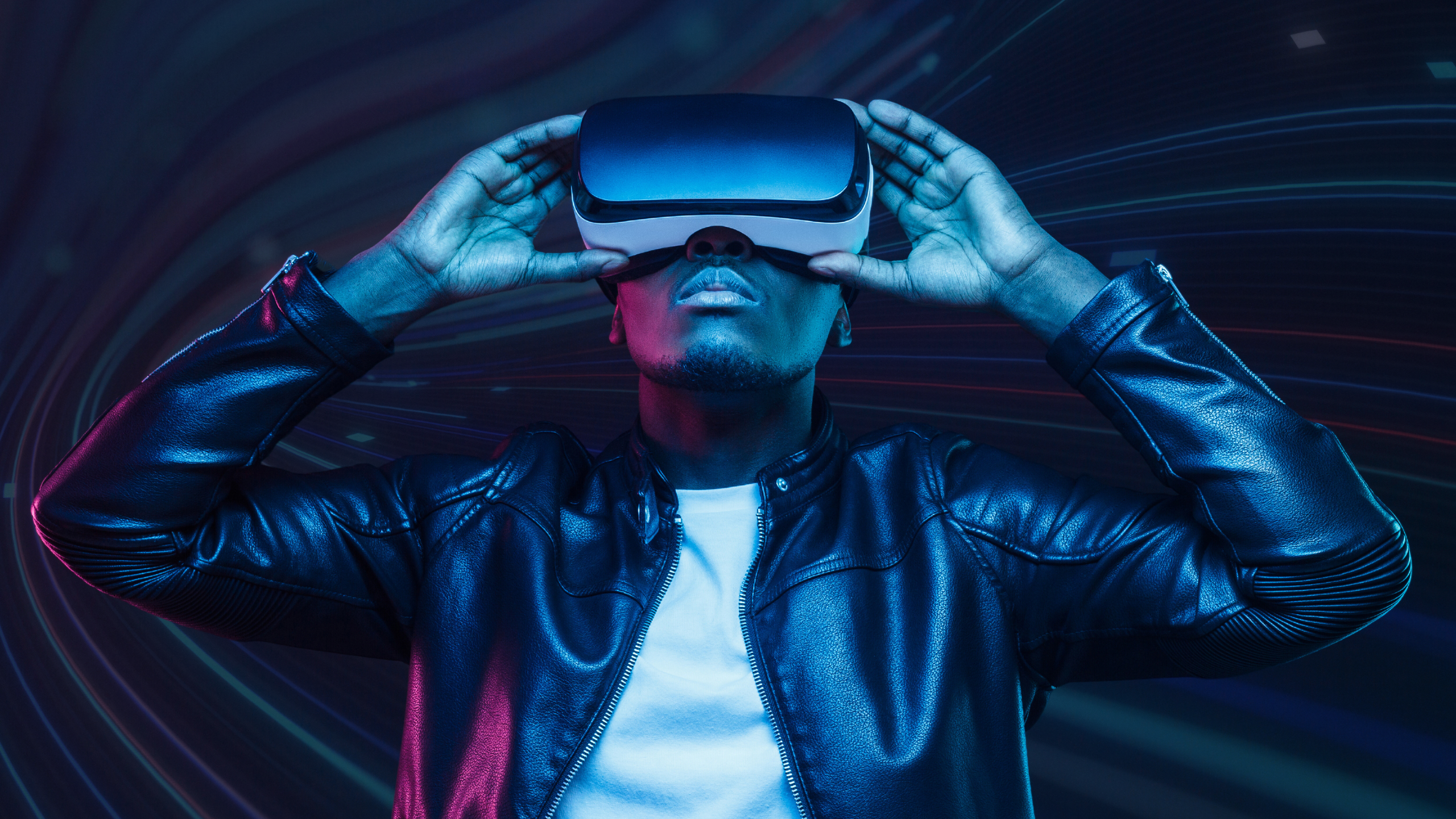
Researchers at Oxford are using AI to curate exhibitions and create symphonies.
They’re looking at the societal impacts of AI and how ethics need to be in the essence of technological advancements. Experts are analysing what AI means for our democratic rights and the day-to-day changes AI will make to our lives.
Protecting society and ensuring ethical uses of AI.
Launched in 2021, the University’s Institute for Ethics in AI brings together world-leading philosophers and other experts in the humanities with the technical developers and users of AI in academia, business and government.
AI is changing every aspect of society – so the Institute’s research team are investigating its ethical impacts from all perspectives.
Multidisciplinary teams from different areas of the University are collaborating to assess AI’s impact on democracy, governance, human rights, human wellbeing, the environment and society.
Led by Professor John Tasioulas from the Department of Philosophy, the Institute became a founding member of the Philosophy, AI and Society Consortium in 2022.
Predicting AI impacts on everyday life.
Researchers at Oxford have investigated what AI means for one of the most relatable aspects of human life – our household chores.
They found that four in ten hours currently devoted to unpaid housework and caring responsibilities could be automated within the next decade.
44%
of housework was thought to be automatable
The team included Dr Lulu Shi, postdoctoral researcher from the Oxford Internet Institute (OII) and departmental lecturer in Oxford’s Department of Education, and Ekaterina Hertog, Associate Professor in AI and Society from the OII and the Institute for Ethics in AI.
The experts predicted that time currently spent on grocery shopping would fall by nearly 60% in ten years, with other domestic tasks such as cooking ripe for automation. Only 28% of physical childcare or taking care of elderly relatives was thought to be automatable by 2033.
Algorithmic vs human curation.
Researchers at the Oxford Internet Institute have also been investigating the use of algorithmic models in visual art curation.
Doctoral researcher Laura Herman collaborated with the artist Fabienne Hess for the exhibition ‘The Algorithmic Pedestal’ at J/M Gallery in January 2023.
The exhibition was developed in order to highlight differences between human and algorithmic ways of seeing.
Photo: Fabienne Hess
Photo: Fabienne Hess
With the rapid growth of generative AI tech such as DALL-E2, Stable Diffusion and Midjourney, questions were being raised about the future of art in the face of automation.
While these generative AI tools receive lots of attention, little is known about the cultural impacts that algorithmic recommendation platforms, for example Instagram, have on visual culture.
Though these platforms aren’t creating content though, they’re curating it.
Researchers used Instagram’s algorithm to select works from the Metropolitan Museum of Art’s open access collection, whereas the artist-led portion of the exhibition showcases artist Fabienne Hess’ image collection, the Dataset of Loss.
At the intersection of AI and the arts.
A report by doctoral researcher Anne Ploin, Professor Rebecca Eynon and Dr Isis Hjorth from the Oxford Internet Institute, and Professor Michael Osborne from the University’s Department of Engineering Science, has investigated the intersection of AI and the arts.
The paper uses a case study of the use of machine learning techniques in artistic work, investigating the scope of AI-enhanced creativity and whether human/algorithm synergies could help unlock human creative potential.
The team interviewed experts who work in the creative arts, including media and fine artists, with the report showcasing a range of artworks and a cover designed by the illustrator Alexandra Francis.
‘While the machine learning models could help produce ‘surprising variations of existing images’, practitioners felt the artist remained irreplaceable in terms of giving images artistic context and intention – that is, in making artworks.’
Among the key findings of the report were that major changes in the use of AI concerned the organisation of creative workflows around the generative process.
Artists found many similarities between contemporary machine learning art and other periods in art history – for example, computer and code-based arts from the 1960s and 1970s, while also highlighting the difference in scope between human and machine creativity.
While machine learning models can help produce surprising variations of existing images, the artist is still irreplaceable in giving the artistic images context and intention.
The report's cover, designed by illustrator Alexandra Francis
The report's cover, designed by illustrator Alexandra Francis
AI and music.
Through collaborations with cultural institutions such as the Royal Northern College of Music (RNCM) in Manchester, and the Old Fire Station in Oxford, researchers in the Department for Engineering Science have been using AI to make music.
Professor David De Roure is Academic Director of the Digital Scholarship @ Oxford initiative, Professor of e-Research at Oxford e-Research Centre, Honorary Visiting Professor at RNCM and a Turing Fellow.
In his role at Oxford, and as part of the Centre for Practice and Research in Science and Music (PRiSM), he has collaborated with composers such as Dr Robert Laidlow, Career Development Fellow in Music at Jesus College, on a number of occasions.
In late 2022, Dr Laidlow’s piece ‘Silicon’, was the first AI composition to perform with the BBC’s Philharmonic Orchestra.
The piece was created by first using an AI to create sheet music, followed by the use of an AI to transform notes into orchestral sounds.
Finally, an AI was trained to generate raw audio using 20 years of BBC Philharmonic Orchestra performances – something that produced ‘wonderful orchestral sounds’ according to Dr Laidlow, but also replicated the presenter and audience sounds.
Professor De Roure, and colleagues from both Oxford University and Oxford Brookes University, also worked with the Urban Music Foundation to explore the interplay between science, technology and hip hop, creating an immersive soundscape installation at the Old Firestation, Oxford.
The audience move through ‘Epochs’ reflecting different eras of music and technology, from the 1950s through to the future, with tracks eventually being created in response to lyrics generated with AI.
Nature, climate and the universe.

Experts at Oxford are using AI to tackle the biggest challenges facing our natural world, from monitoring the illegal wildlife trade to ensuring net zero targets are met.
They are uncovering previously unknown secrets of our universe; supporting the search for life beyond earth, decoding animal languages and using machine learning to detect natural disasters from space.
Monitoring wildlife and aiding conservation.
Researchers from the Department of Biology and the Oxford Internet Institute are using computational approaches to monitor the growing illegal wildlife trade online through The Oxford Martin Programme on Wildlife Trade.
The research team, including Dr Joss Wright, Professor Dame E.J. Milner-Gulland and Dr Amy Hinsley, are developing new frameworks for understanding the drivers and characteristics of online consumer behaviour, and possible interventions, in order to reduce trade in wildlife products.
$10bn
estimated value of the illegal wildlife trade
By trailing new approaches for monitoring online, the programme fills a global need for a multi-disciplinary research hub on the illegal wildlife trade and facilitates real-world conservation impact.
The Oxford AI4Science (Artificial Intelligence for Science) Lab is part of the Department of Computer Science and is led by Dr Atılım Güneş Baydin.
The Lab’s Seismic Savannah project is using machine learning to differentiate elephants from other species in Kenya, and identify important behaviours such as running, using seismic data generated by the animals.
Their unique dataset offers substantial opportunities and benefits for wildlife monitoring.
Decoding the language of whales with AI.
A ground-breaking, collaborative research project is using advanced machine learning and robotics to decode the communication of whales.
Project CETI (Cetacean Translation Initiative) is a TED Audacious Prize winning collaboration made up of the world’s leading artificial intelligence and natural language processing experts and scientists from a network of universities and other partners.
Professor Michael Bronstein, DeepMind Professor of AI in the Department of Computer Science, is Principal Investigator and Machine Learning Lead for the project, which utilises recent breakthroughs in AI and unsupervised machine translation to listen to and translate the communication of sperm whales, with hopes of talking back.
Space exploration and monitoring.
A study involving researchers from the Department of Computer Science has found that artificial intelligence could accelerate the search for extra-terrestrial life by suggesting the most promising places to look.
The team, including Dr Freddie Kalaitzis, demonstrated that AI and machine learning methods can identify hidden patterns within geological data that could indicate the presence of life, supporting collection samples from Mars or elsewhere.
‘Our process combined statistical microbial ecology surveys, remote sensing from unmanned aerial vehicles, and machine learning…in a Mars-relevant setting.’
Elsewhere in the Department of Computer Science, researchers led by DPhil student Vít Růžička have successfully trained a machine learning model in outer space for the first time.
Supervised by Professor Andrew Markham, the team’s achievement could enable real-time monitoring and decision making for a range of applications, from disaster management to deforestation.
‘Machine learning has a huge potential for improving remote sensing – the ability to push as much intelligence as possible into satellites will make space-based sensing increasingly autonomous.’
Detecting floods from space.
A new AI technology pioneered by Oxford researchers, in partnership with the European Space Agency’s (ESA) Φ-lab, was deployed on a mission to pilot the detection of flood events from space.
The Oxford team, led by Dr Atılım Güneş Baydin from the Department of Computer Science, developed a machine learning model called ‘Worldfloods’ designed specifically for deployment in specialized hardware in space on low-cost satellites in Low Earth Orbit.
The model has major implications in bringing down the cost of flood detection and disaster response technologies, and making these accessible for low-income countries.
‘It's a very significant step in bringing machine learning and artificial intelligence operations to space.’
Detecting unregulated air pollution.
A collaborative between researchers from the Centre for Statistics in Medicine and Lahore University of Management Sciences is combining the power of artificial intelligence with remote satellite imagery to help tackle the problem of unregulated brick kilns across South Asia.
Led in Oxford by Associate Professor Sara Khalid, the project has developed an improved, faster model for detecting the kilns across Pakistan, India, Bangladesh, and Nepal, which are a major source of air pollution, a key contributor to climate change, and connected to people trafficking and modern-day slavery.
‘The model provides a rapid, accurate and highly scalable tool to automatically detect and map brick kilns across this vast region.’
Optimising the transition to Net Zero with AI.
Oxford Net Zero is an interdisciplinary research initiative coordinating with other academic institutions and research hubs around the world to inform climate action in line with the goals of the Paris Agreement.
Net Zero Tracker, led by Oxford Net Zero, is a global initiative co-led by Professor Thomas Hale from the Blavatnik School of Government, which provides a definitive register of net zero targets set by countries, states and regions, cities and large companies.
Chat Net Zero, a new tool from Net Zero Tracker, is a large language model (LLM)-based chatbot and question-answering platform able to decipher the complicated language around ‘net zero’, with an aim of transparency and accountability to net zero pledges made.
Researchers from the Smith School of Enterprise and the Environment are using large language models (LLMs) to counteract climate misinformation.
Dr Julia Bingler co-designed ClimateBert, a natural language processing algorithm which provides researchers and practitioners with a tool that outperforms previous methods to extract and analyse climate-related text from companies’ climate-related reports and net zero commitments.
In 2023 the team released chatClimate, a prototype AI conversational chatbot aimed at making climate risk and information accessible to a broad audience.
A new, collaborative AI project from the Department of Engineering Science is using machine learning methods to revolutionise the optimisation of a range of energy and transport systems and support the UK’s journey to net zero targets.
Led in Oxford by Associate Professor Konstantina Vogiatzaki, the project brings together researchers from Imperial College London and the universities of Cambridge, Oxford, and Edinburgh to combine ‘digital twins’ and energy-efficient AI algorithms with industry engagement to produce evidence-based examples for energy and transport optimisation.
Professor Vogiatzaki’s work focuses on maximising the reliability, safety, and operational efficiency of hydrogen-based systems, building upon the achievements of a previous UKRI Innovation Fellowship.
‘We are delighted to collaborate with such a talented consortium of leading researchers, towards bringing a step change in net zero pathway by leveraging the amazing breakthroughs in modern techniques of AI.’
A new generation of sky surveys.
Dr Heloise Stevance from the Department of Physics is undertaking a research project to create a Virtual Research Assistant (V.R.A) for a new generation of sky surveys.
As a recipient of The Eric and Wendy Schmidt AI in Science Fellowship, Dr Stevance will be addressing a need for classifying cosmic explosions observed in the night sky, the number of which has surpassed the research community’s ability to investigate.
Working with Professors Stephen Smartt and Stephen Roberts from the Departments of Physics and Engineering Science, Dr Stevance will create a first working prototype of the V.R.A. before the new Vera Rubin Observatory opens its dome in 2024.
Discovering the ingredients of the universe.
Another recipient of The Eric and Wendy Schmidt AI in Science Fellowship, Dr Holly Pacey from the Department of Physics is a member of the ATLAS collaboration, the largest experiment in CERN's Large Hadron Collider complex.
Dr Pacey develops machine learning algorithms to search for the fundamental ingredients of the universe beyond our 'Standard Model' of particle physics. The project will develop Graph Neural Networks for improved particle collision classification.
Politics, business and the economy.

Experts at Oxford are investigating how AI is transforming economics, the business world and political landscapes.
They are uncovering how AI is affecting political elections and bureaucratic institutions, pioneering research in the financial sector and discovering what the future of work will look like.
Understanding the impact of AI on government and policy.
The Digital Politics and Government group at the Oxford Internet Institute brings together experts to examine how the Internet has transformed the political world, and uses data science to understand these behaviours.
A project led by Dr Keegan McBride looks at Bureaucracy and Artificial Intelligence and explores how public sector bureaucracies reconcile their existing institutional logics and values with those of newly introduced AI systems.
The Institute’s Programme on Democracy and Technology investigates the use of algorithms, automation, and computational propaganda in public life. Led by Professor Philip Howard, the programme’s research addresses the use of propaganda and misinformation in elections and in the media.
AI is increasingly considered a strategic technology that can provide significant economic, social, and military advantages.
The political geography of AI infrastructure project, also at the Oxford Internet Institute and led by Professor Vili Lehdonvirta, seeks to map the political geography of the computing power infrastructure that underlies advanced AI.
70%
of the global cloud infrastructure is estimated to be owned by Amazon, Microsoft, and Google
The Oxford Martin School’s AI Governance Initiative aims to understand and anticipate the lasting risks from AI through technical and computational research, combined with policy analysis.
Led by Professors Michael Osborne and Robert Trager, the Initiative’s research will be used to support decision-makers from industry, government and civil society to mitigate AI’s challenges and realise its benefits.
Reducing harm in online markets.
A study from researchers at the Oxford Internet Institute and Imperial College London found that widespread use of intelligent algorithmics and dynamic pricing by online retailers puts the public at risk of collusion among sellers.
Led by Dr Luc Rocher, the research highlights how such ‘adversarial collusion’ can have negative consequences for consumers, enabling sellers to coordinate their prices and potentially increase their profits at the expense of consumers.
The researchers have called for policymakers and regulatory agencies to consider how current laws or enforcement priorities may not cover manipulations of algorithmic pricing.
‘Our research highlights how intelligent machine learning algorithms could find vulnerabilities in the system.’
AI in finance and investing.
Experts from the Oxford Sustainable Finance Group, part of the Smith School of Enterprise and the Environment, are pioneering a new area of research called ‘spatial finance’, a term coined by the team led by Dr Ben Caldecott.
Their work integrates geospatial data and analysis into financial theory and practice.
Rapid developments in geographical data gathering, and advances in machine learning, mean that these datasets can be processed in near-real time and at scale, making them relevant for many financial institution applications.
The combination of these technologies has the potential to transform how risks, opportunities and impacts are measured and managed by financial institutions.
In 2023, a 3-year partnership with Barclays, the Oxford Sustainable Finance Group and the UK Centre for Greening Finance and Investment was announced.
‘We are delighted to partner with Barclays on this project, creating open data and analytics that can drive better financial decisions.’
This ground-breaking project will establish decarbonisation pathways for the financial sector and methods for measuring farm-level greenhouse gas emissions.
The publicly shared outcomes will be used by Barclays to set emissions reduction targets for the agriculture sector, in support of the bank’s net zero ambition and commitment to align its financing to the goals and timelines of the Paris Agreement.
AI improving the legal sector.
A study involving researchers from Saïd Business School and the Faculty of Law found that the use of AI-assisted lawtech – technology that aims to support, supplement or replace traditional methods for delivering legal service – is changing the way law firms operate by making them more efficient and collaborative.
50%
of lawyers in England and Wales reported using AI
The researchers, including Professors Mari Sako and John Armour, aimed to identify how constraints on using AI in legal services can be safely relaxed to unlock its potential, and further improve the way the legal sector operates.
Their findings advocated for a change of government policy regarding access to publicly owned data and called for guidance from professional and data regulators to bring clarity about data usage in AI-lawtech solutions development, to help further unlock its potential.
‘Our report paints a broadly positive picture of the impact of AI lawtech on the English and Welsh legal sector.’
AI boosting the startup ecosystem.
OpenOcean, a leading European venture capital firm, and researchers from Saïd Business School teamed up to release O3, the world’s most accurate open-access startup insights platform.
$134.4bn
estimated value of the image recognition market by 2023
The O3 platform maps the UK AI startup ecosystem to provide valuable data for all stakeholder, bringing together the expertise of venture capital, the tech industry and academia, setting a new benchmark for accuracy in startup evaluation.
Researchers working on O3, including Professor Mari Sako, have uncovered brand-new insights for the UK tech sector, including that the number of startups with a clear AI offering today is less than 10% of the total ecosystem.
The insights provided by the platform will be critical to ensuring UK leadership on AI.
‘We believe this platform has immense potential to aid innovators in making informed decisions based on sound data, and to boost research on AI.’
An AI spinout from the research of the Oxford Department of International Development is offering an affordable tech valuation tool to help innovators and startups access funding.
A key barrier that prevents innovative ideas translating into viable products is cost; OxValue.AI offers a new approach which seeks to make technology pricing objective, affordable and accessible to all those who need it.
OxValue.AI is based on an algorithm developed by Professor Xiaolan Fu and has a particular aim to facilitate the dissemination of technologies to countries in the Global South.
Transforming the future of work.
In 2013, Professors Carl-Benedikt Frey and Michael Osborne from the Oxford Martin School released a paper that predicted nearly half of all US jobs were at risk of automation.
This research led to the Oxford Martin Programme on the Future of Work, which will provide an in-depth understanding of how technology is transforming the economy, to help leaders transition into new ways of working in the 21st Century.
‘We are trying to understand the history and the future of job automation. To dismiss the threat of automation is to get the history wrong.’
Elsewhere in the Oxford Martin School, researchers have investigated the potential Generative AI has in transforming work across industries, boosting productivity and democratising innovation.
Professor Ian Goldin and Dr Pantelis Koutroumpis found that while Generative AI offers enormous potential to accelerate solutions to the world’s biggest challenges, it also could destroy jobs, undermine democracy and widen inequalities and the divisions within our society and between countries.
‘The challenge now is to develop the regulatory frameworks and guardrails required to ensure its benefits are widely shared and sustained.’
New research from the Oxford Internet Institute aims to understand the implications of new technologies on the future of employment and training, in particular for unpaid domestic work.
The UKRI ESRC-funded DomesticAI project is led by Professor Ekaterina Hertog and will scope the potential of new gadgets and apps to free up time now locked into unpaid housework and care work, and assess how willing we are to introduce these technologies into our private lives.
In another Oxford Internet Institute study, Dr Fabian Stephany found that workers with artificial intelligence skills are particularly valuable, in part because these skills can be combined with other valuable skills.
The research, focused on 962 skills and 25,000 workers, found that programming languages and data science were among the most valuable skills, and the higher the potential of a skill to be combined with others, the higher its own value.
up to 40%
higher salaries for workers with artificial intelligence skills
Technology and the future.
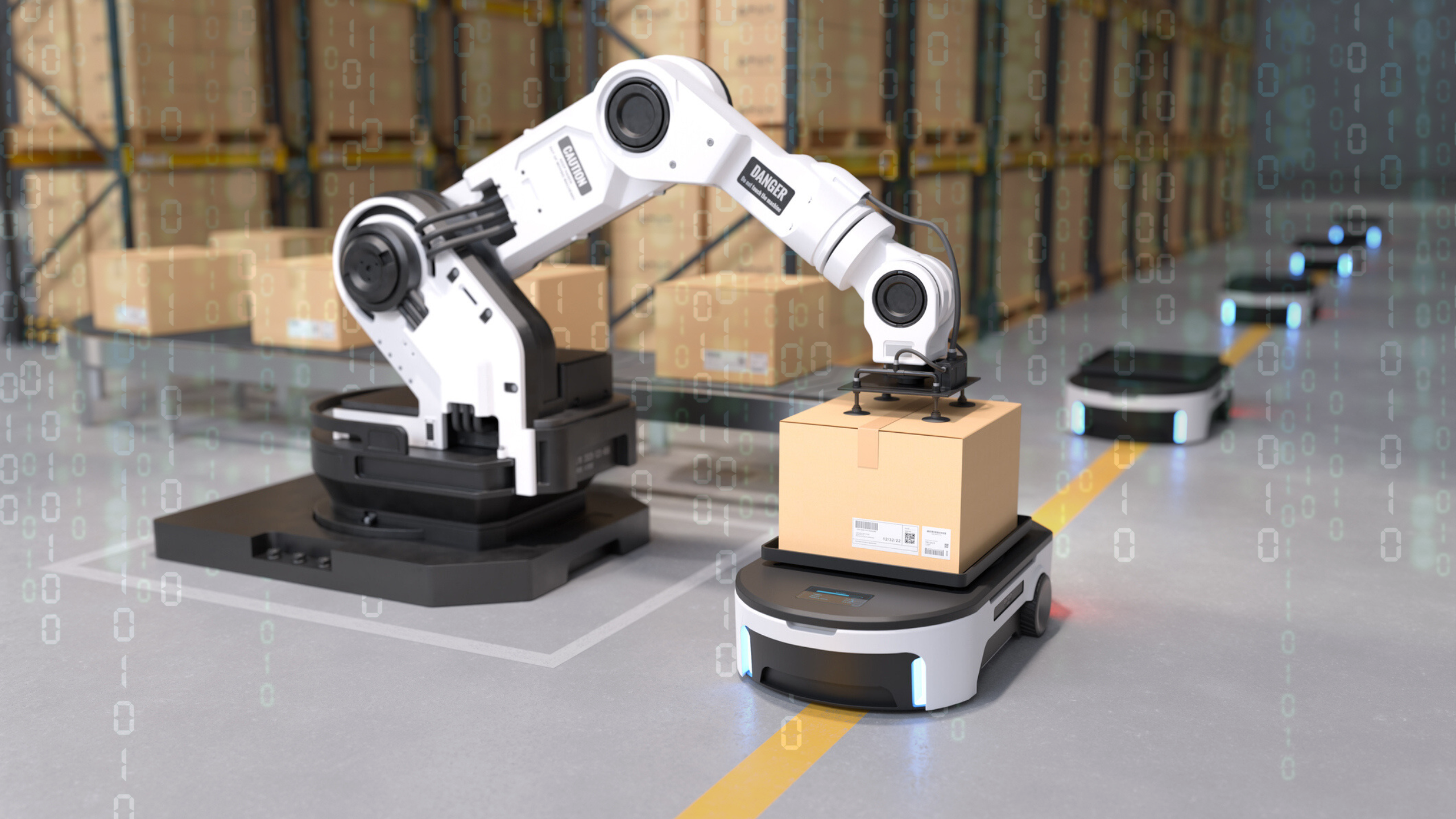
Oxford's researchers are using AI to drive new technologies that are shaping the future of our world. From driverless vehicles and robotics, to clean energy and ecosystem monitoring, our experts are uncovering how machine learning can benefit humans in the workplace, on the roads and beyond.
They are tackling the biggest challenges facing society, and advancing AI governance to ensure the responsible deployment of these technologies on a global scale.
Autonomous robots for service operations.
Oxford experts at the Oxford Robotics Institute, part of the Department of Engineering Science, are investigating how robots can be used to help humans, using machine learning and AI.
Betty is a MetraLabs SCITOS A5 robot, designed for indoor service operations in office and care home settings. Betty arrived with Professor Nick Hawes when he joined the ORI as Director in 2017.
In 2019, Betty spent time in Blenheim Palace’s Great Hall greeting tourists and providing information about the palace and its history.
Professor Hawkes spoke to Oxford Spark’s Big Questions Podcast about the challenges and possibilities of using autonomous robots for tasks unsuitable for humans, such as underwater monitoring of ecosystem changes.
Driverless vehicles.
The Oxford Robotics Institute was founded by Professor Paul Newman, who led the development of a suite of technology that enabled autonomous vehicles, such as driverless cars, to navigate independently of infrastructure.
In 2015, Professor Newman and Professor Ingmar Posner spun out Oxbotica (now Oxa) to commercialise their autonomous vehicle software and revolutionise what everyday vehicles can do for society.
‘Oxbotica was founded on the vision of Universal Autonomy™ — providing safe and sustainable autonomy that is independent of workplace and vehicle type.’
As of 2023, Oxa has scaled significantly and worked with a wide range of industry partners including Applied EV to equip prototype vehicles with its software, which have already operated with no on-board driver on a publicly accessible road in Oxford.
Researchers from the Department of Computer Science collaboratively developed a new AI system to equip autonomous vehicles with safer and more reliable navigation, especially under adverse weather conditions.
Supervised by Professors Niki Trigoni and Andrew Markham, DPhil student Yasin Almalioglu and colleagues developed a new, self-supervised deep learning model to address the challenges faced by automated vehicles in difficult weather, which can result in imprecise positioning.
‘Estimating the precise location of automated vehicles is a critical milestone to achieving reliable autonomous driving under challenging conditions.’
Robots for a safer world.
In 2021, The Oxford Robotics Institute was awarded funding from the UKRI Industrial Strategy Challenge Fund to undertake research for the development of new technologies to operate in extreme and challenging environments.
These include environments which are dangerous to work in, or hard to reach, such as those found in the nuclear power and offshore energy industries.
The Robotics and Artificial Intelligence in Nuclear Hub (RAIN Hub) is a collaborative research programme aiming to lower costs and risks within the nuclear industry by reducing timescales, improving safety, promoting remote inspection, and reducing the chances of human exposure to radiation and other hazards.
In 2021, the ORI had a major field trial at JET (the Joint European Torus), at the UKAEA site in Culham. The trial demonstrated the value of robotics to the nuclear industry, paving the way for future robots to operate safely in environments that would otherwise be too dangerous for humans.
Powering mobile autonomous devices.
SMARTEDGE (Semantic Low-code Programming Tools for Edge Intelligence) is a new EU Horizon project that aims to provide solutions for applications requiring quick response time from mobile autonomous devices.
The €9.2 million project aims to manage the intelligence required by mobile autonomous applications such as transportation, manufacturing, health applications and smart cities.
‘We are delighted to collaborate with such a talented consortium of leading researchers, enabling a step change in edge intelligence, with applications to everyday life.’
The Oxford team, including Associate Professor Noa Zilberman from the Department of Engineering Science, is leading the work on dynamic swarm networks key to the reliability, security and privacy of the operation.
Boosting processing power for AI tasks.
Oxford researchers, along with collaborators from the Universities of Muenster, Heidelberg, and Exeter, published a paper reporting on their development of integrated photonic-electronic hardware capable of processing three-dimensional (3D) data, substantially boosting data processing power for AI tasks.
100x
enhancement in energy efficiency that this approach could provide
The paper builds on the ground-breaking work of the team, including Dr Bowei Dong and Professor Harish Bhaskaran, from the Department of Materials, published in 2021which demonstrated crucial tasks for AI and machine learning applications.
This work resulted in the birth of the photonic AI company spin-out, Salience Labs.
AI powering clean energy.
Oxford researchers have joined a multi-institutional team that will explore a new method for creating fusion power with hopes it could eventually be scaled to provide safe, clean, and abundant energy.
Support for the project comes from a combined £12 million from University of Oxford spinout First Light Fusion, the company behind this new approach, and UK Research and Innovation’s Prosperity Partnership scheme.
‘Machine learning tools have an important role to play in exploring the extreme states of matter required to deliver fusion…This partnership brings together the expertise needed to address this grand challenge.'
Professor Dan Eakins from the Department of Engineering Science and Professors Gianluca Gregori and Sam Vinko from the Department of Physics will work with colleagues from Imperial College London and the University of York to investigate the new technique for scalable fusion.
Industry partner Machine Discovery, also a University of Oxford spinout, will be providing an AI-Powered solution for compute-intensive tasks to achieve significant productivity, helping to accelerate the development of the new approach.
Human-AI coordination.
In March 2023, Professor Jakob Foerster from the Department of Engineering Science was awarded an ERC starting grant for the development of new machine learning algorithms for human-AI coordination, which could have important applications in situations where humans and robots work alongside each other, such as in warehouses or service settings.
The funding will assist Professor Foerster in setting the foundations for AI systems that interact smoothly with human users in complex settings such as mixed-autonomy teams or traffic situations.
‘Current machine learning algorithms are really good at using large scale computing power to beat humans at games.. Wouldn’t it be great if we could also use it to help and support humans?’
Responsible AI for the future.
In 2023, Aioi R&D Lab was launched by Oxford spinout Mind Foundry in partnership with insurance brand Aioi Nissay Dowa Insurance and Aioi Nissay Dowa Europe.
The Lab brings together the insights and expertise that has already delivered improvements in safe driving and automation, to work on real-world solutions to some of the most significant challenges facing societies around the world, from the climate crisis and ageing populations to the impact of increased automation.
Aioi R&D Lab will be supported by an advisory board of University of Oxford professors with expertise across many disciplines, including Mind Foundry co-founders Professor Stephen Roberts and Professor Michael Osborne, Professor Malcolm McCulloch of the Energy and Power Group and Professor Paul Newman of the Oxford Robotics Institute.
‘AI is one of a small number of transformational technologies that will truly change the face of our society and planet - I don’t think there is any way we can tackle the core challenges of the century without it.’
The RAILS project - Responsible AI for Long-term Trustworthy Autonomous Systems – is led by Dr Larz Kunze from The Oxford Robotics Institute, and is focused on questions of responsibility and how these are understood, mapped, and experienced within the domain of autonomous vehicles.
The mutlidisciplinary team from Oxford, UCL and the universities of York and Leeds will examine the social and legal contexts, as well as technical requirements, of autonomous vehicle and robot systems in order to assess how these systems can be designed, developed, and operated in a way that is socially responsible.
Tackling AI’s biggest challenges.
In 2023, Professor Michael Bronstein from the Department of Computer Science, and Professor Alison Noble from the Department of Engineering Science, were awarded UKRI Turing AI World-Leading Fellowships to conduct ground-breaking work on some of AI’s biggest challenges.
Professor Bronstein will develop a new machine learning framework for drug and food design, building on his research which has focused on a broad range of applications, from computer vision and pattern recognition to biochemistry, drug design, and animal communication.
Professor Noble will continue her research which sits at the interface of AI with computer vision and clinical medicine, with a focus on bringing machine learning to ultrasound.
‘My fellowship aims to develop new AI for shared human-machine decision-making in healthcare imaging including studying ethics of the AI and technology trustworthiness.’
More on #OxfordAI



